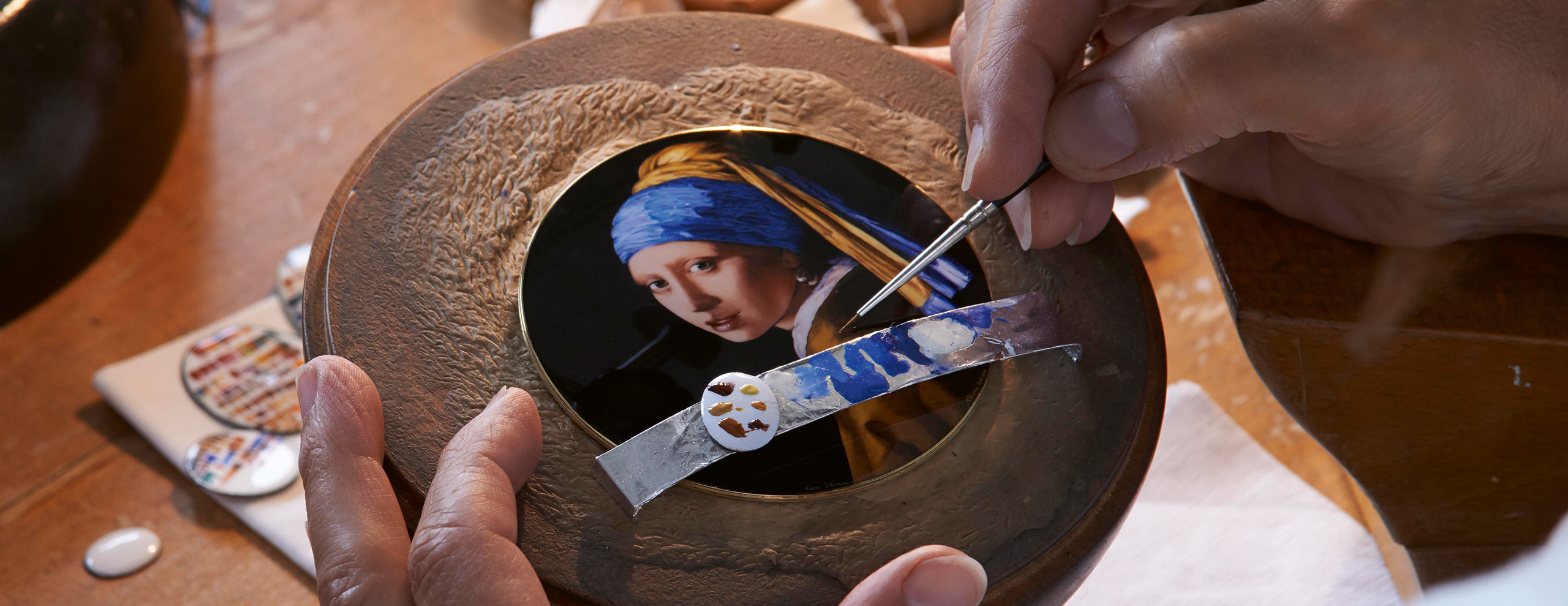News
Understanding Métiers d’Arts: Enameling
News
Understanding Métiers d’Arts: Enameling
ENAMELING: The Art of Color
In the realm of timekeeping, wristwatches reign supreme as the embodiment of romance. They require dials that often rival the case itself in size, a necessity to ensure the clarity of time-telling. But the dial is far more than a mere functional component. It is the defining element that can elevate an ordinary watch into a captivating work of art. An exceptional watch may boast intricate mechanics and impeccable craftsmanship, yet without a dial that meets the lofty standards of aesthetics, it falls short of enchanting our sensibilities. Conversely, an unassuming daily companion can transcend into an object of fascination when adorned with a beautifully crafted dial.
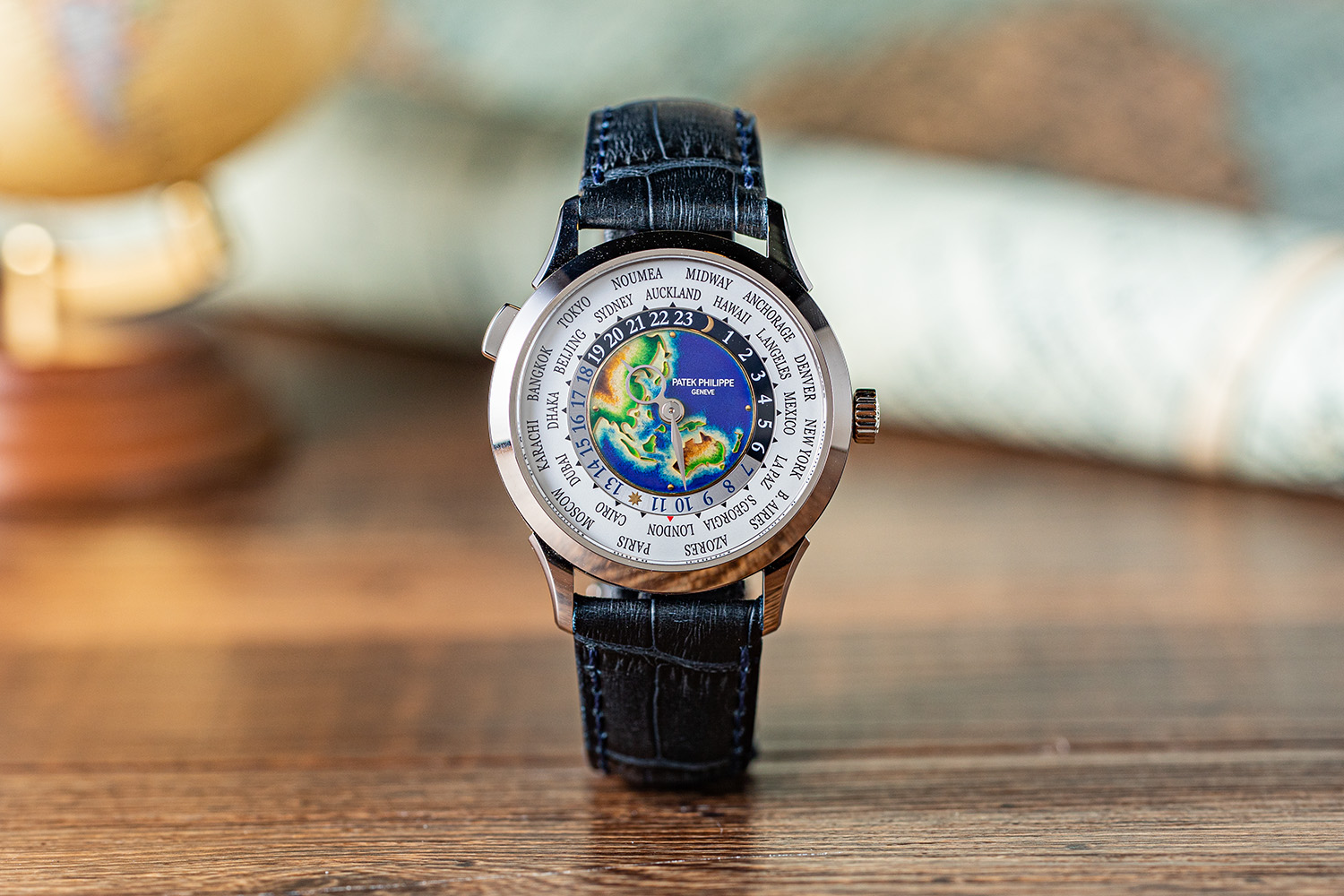
The Patek Philippe World Time ref. 5231G with a cloisonné enamel dial depicting Oceania and Southeast Asia
The modern age has granted us the privilege of accessing well-crafted watch dials at remarkably affordable price points. Lacquer finishes, captivating sunray brushed patterns, intricate guilloché, and a plethora of ornate designs are all within reach. Japanese watches, in particular, have made a name for themselves by offering intricate dials, resplendent with vibrant colors and elaborate patterns, at prices that don’t burden the wallet. However, as one delves deeper into their collection and explores the myriad dial varieties, they will invariably encounter the revered word: enamel. The rarity of enamel in contemporary watchmaking has rendered it somewhat enigmatic to many enthusiasts. It was once a commonly practiced art before other industrial methods of mass production and the insatiable chase for maximum profit took over. Typically reserved for watches that come with a hefty price tag, enamel retains an air of mystery. For instance, what are the differences between cloisonné, champlevé and flinqué enamel? Even more fundamental questions, such as understanding the basics of grand feu enamel or discerning the elements that define a high quality enamel dial worthy of its price, can be a daunting endeavor.
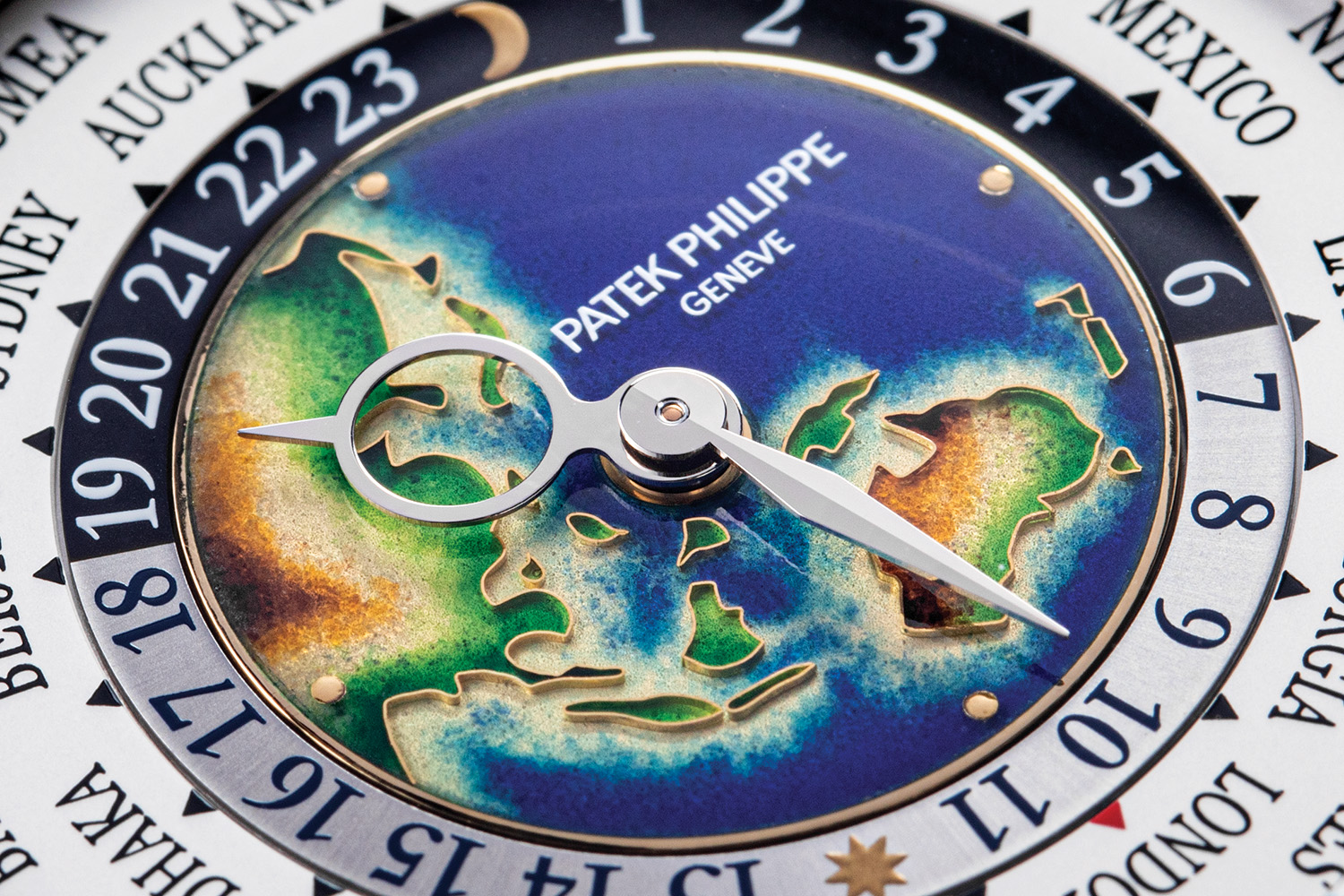
A typical application of the cloisonné technique can be observed in this modern Patek Philippe World Time ref. 5231G with an “Oceania and Southeast Asia” dial
Hence, we invite you to embark on an immersive journey into the captivating realm of enameling. Recently, our team had the opportunity to visit an enamel dial making facility in Switzerland, and we are thrilled to unveil the secrets surrounding this intricate art form. In this exploration, we will delve into what enameling is, how it is made, how to evaluate its quality, and discover the artisans who create the finest enamel dials across various price ranges today.
WHAT ARE ENAMEL DIALS?
An art with a history spanning millennia, enamel, at its core, is a fusion of painting and firing techniques. It yields a hard, luminous layer of paint, exhibiting a distinctive sheen that emanates a warm and lustrous glow. Enamel may present itself in various forms, from transparent and opaque to opalescent, and it can integrate with techniques like engraving, painting or wire framing, some of which are exclusive to the world of horology.
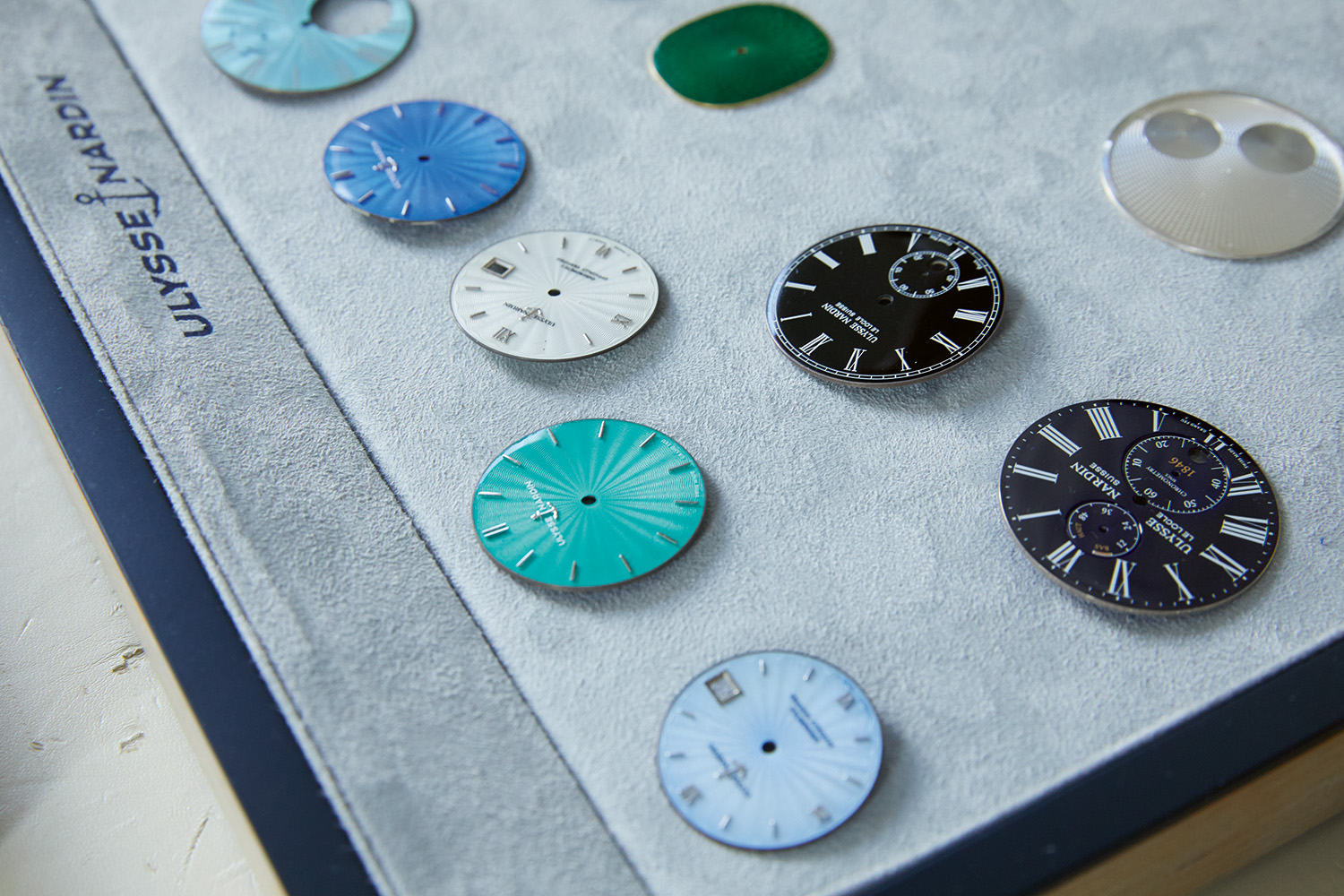
Our editors perused a selection of enamel dials during the visit to Donzé Cadrans
What makes enamel particularly intriguing in its application to watchmaking is the scale. Dials are remarkably small compared to enameled cases or vases, yet they capture the traditional complexity and beauty of this art. Importantly, an enameled piece is not only visually stunning but also highly durable; it doesn’t age or tarnish, and it can even be safely cleaned in an ultrasonic bath without any adverse effects. But what exactly is enamel, and how does it differ from glass or porcelain? Despite its primary composition being silica, enamel stands apart as a specialized type of glass. It requires specific techniques and a fusing process to adhere it to a baseplate, typically made of metal. While fusing might seem like a straightforward task, there’s some science involved.
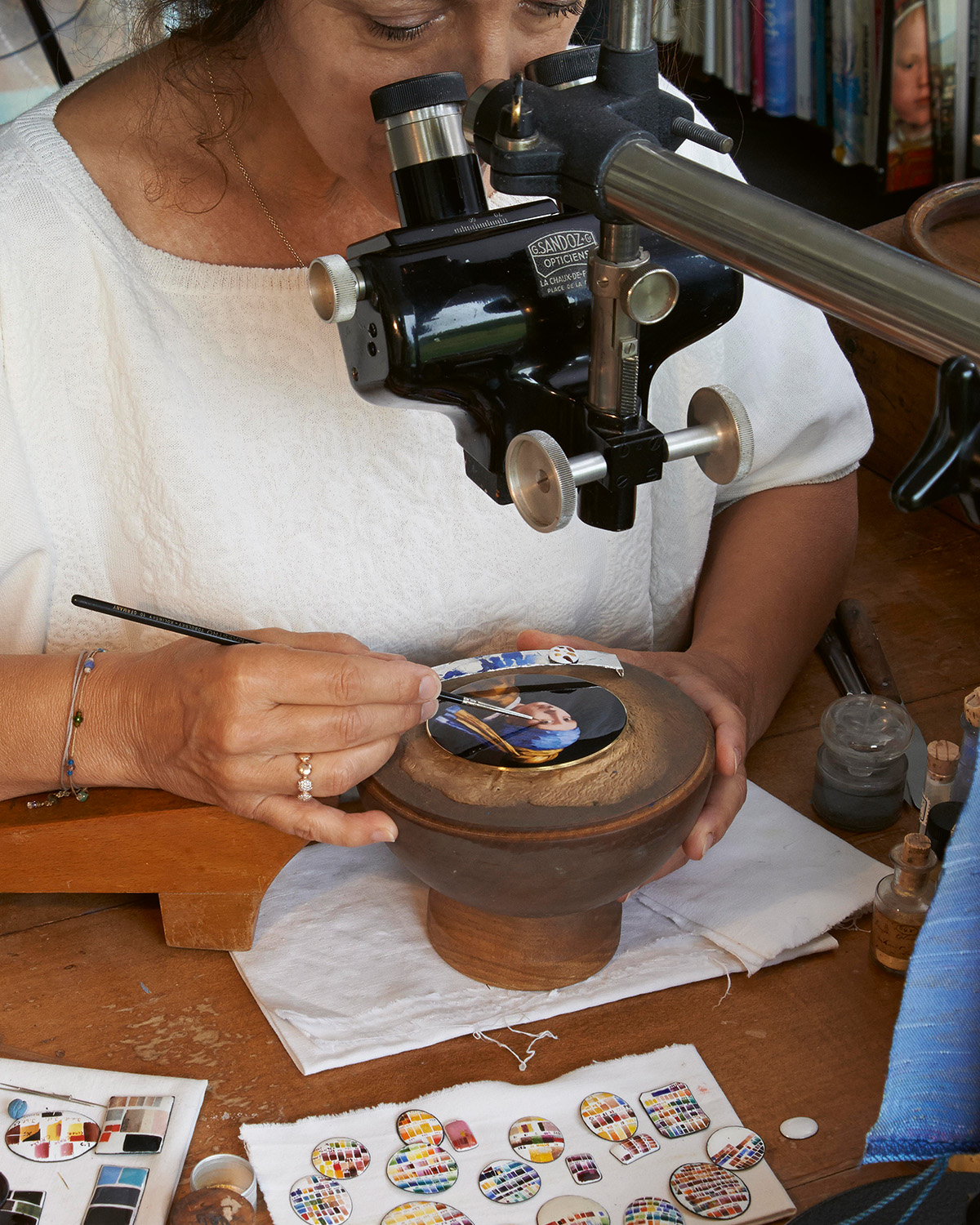
Renowned enameler Anita Porchet carefully tests the palettes before creating her masterpiece, a stunning reproduction of Johannes Vermeer’s Girl with a Pearl Earring (Image: Vacheron Constantin)
Here’s the dilemma: the typical firing temperature of glass is north of 1,300 degrees Celsius, but the melting point of common enamel baseplates made of metals such as copper and gold is around 1,000 degrees Celsius. Therefore, there needs to be a “magic” to lower the firing temperature to avoid the melting of the baseplate in the fusion process while still retaining the beautiful vibrant look of colorful glass. To achieve this lower temperature where the enamel powder becomes fluid, “flux” is added. Common “fluxes” include sodium carbonate, also recognized as soda ash, and potassium hydroxide, commonly known as potash. The melting process also explains the name of the craft, enamel, which is derived from the Old High German word “smelzan” and the Old French word “esmail,” both meaning “to smelt” or “to fuse.” This etymology reflects the process of creating enamel, which involves fusing powdered glass onto a surface through intense heat. It’s worth noting that the melting and fusing process wouldn’t be complete without the addition of stabilizers, contributing to the enamel’s hardness and rendering it insoluble. Common stabilizers include lead oxide and lead tetroxide. However, what sets enamel dials apart and demands the deft hand of the artisan? This article’s objective is precisely to uncover the craftsmanship by delving into the technical and artisanal complexities of enameling.
HOW ARE ENAMEL DIALS MADE?
Producing a high quality enamel dial begins with the proper preparation of raw materials. As enameler Gabriel Colliard emphasizes, “The preparation and cleaning of enamels are fundamental to the art of enameling, and much of the work’s success depends on these initial steps.” Typically, raw enamel material is sourced from specialist suppliers rather than being produced in-house. In the supplier’s factory, the production of enamel powder involves creating a fused mixture primarily composed of silica, with the addition of metal oxides for coloration. Once this fused mixture has cooled, it is then broken down into either rock or powdered form.
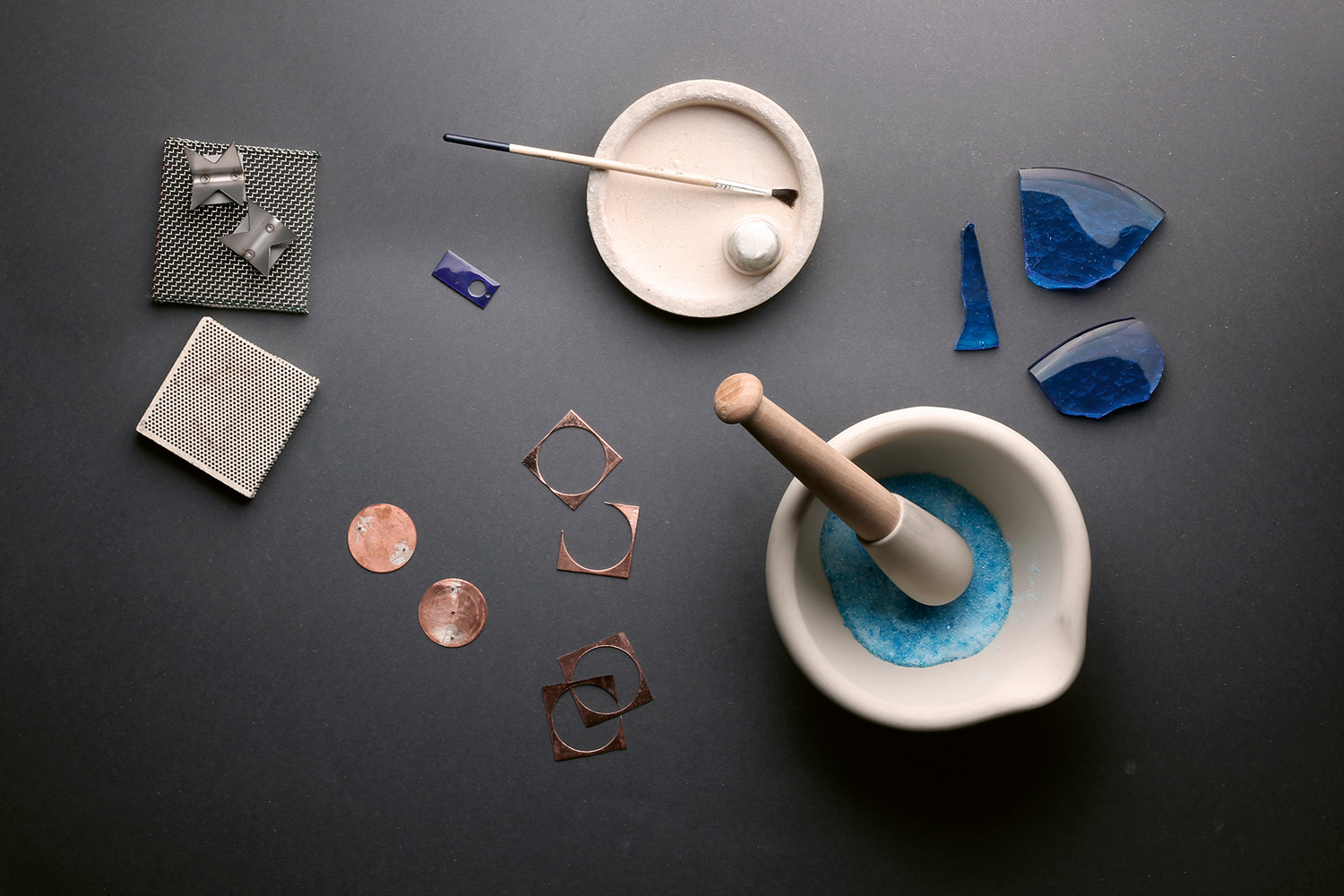
The process and tools used in creating an enamel dial. The pestle and mortar at the bottom right are used for grinding the raw material (Image: anOrdain)
In cases where the enamel arrives at the dial making facility in rock form, the enameler must manually grind it to achieve the desired granularity. Lewis Heath, the founder of anOrdain, notes that the manual grinding and cleaning process not only provides artisans with greater control over particle sizes, but also ensures that the enamel remains uncontaminated.
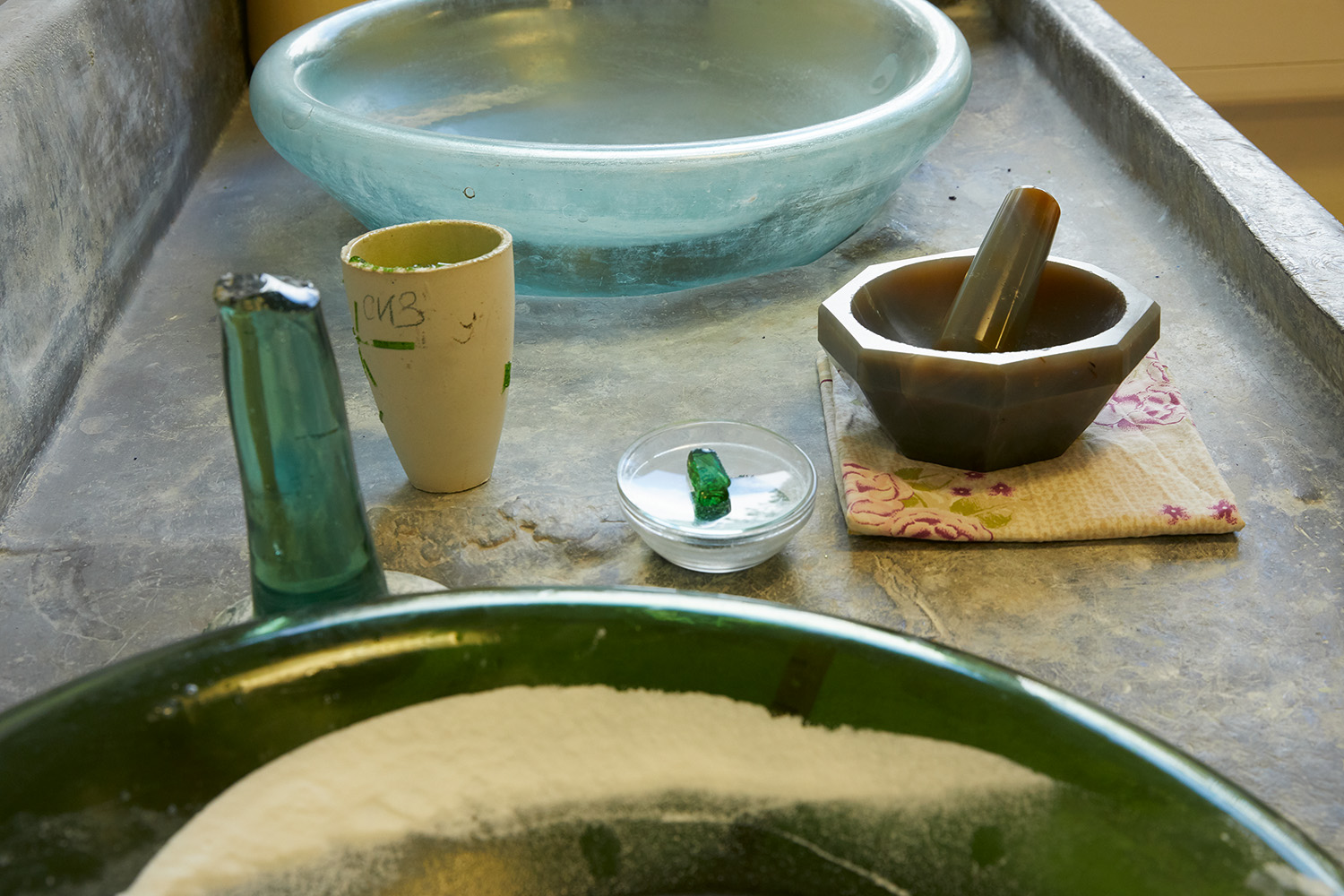
What it takes to grind fused enamel into powder form
GETTING THE DIAL BLANKS READY
Dial blanks also require attentive preparation. Traditionally, they are crafted from precious metals like gold and silver. In modern times, materials such as copper, steel and ceramic have found their place in blank production. These metal blanks must undergo thorough cleaning before the application of enamel to prevent any contamination of the enamel’s color. It’s important to highlight that each material offers unique advantages. For example, gold is highly stable and resistant to corrosion and oxidation, making it an excellent choice for dial blanks. White gold, in particular, is preferred over yellow and pink gold due to the latter materials’ copper content, which can oxidize and affect the enamel’s color. Another notable advantage of gold is its resistance to deformation even after multiple firings. Enamelers have observed that even after more than 100 firings, a gold blank remains stable.
Copper, on the other hand, is susceptible to oxidation, which can lead to the contamination of the enamel. However, given the fact that copper is a relatively common material for an enamel base, there are strategies to address this concern. These include the use of thicker dial blanks, reducing the number of firings, or opting for opaque enamel. Like other materials, copper is also subject to deformation after multiple firings, necessitating post-firing dial flattening. It’s worth noting that copper is a valuable choice for conducting tests and exploring a wide array of color options.
An interesting historical perspective, as highlighted by Claude-Eric Jan, director of Donzé Cadrans, reveals that prestigious brands crafted antique dials using copper blanks over three centuries ago. Another notable artisanal use of copper as a base can be observed in Chinese cloisonné enamelware, which thrived during the Ming dynasty’s Jingtai era. These historical examples highlight copper’s historical suitability in artisanal contexts, though with distinct limitations — it is less suitable for achieving translucent or opalescent enamel effects. In the contemporary world, copper’s affordability positions it as a practical choice for modern enamel dials, broadening access to a wider audience. It has become a common material for entry-level enamel dials, as seen in the ivory enamel dial showcased in the Louis Erard Excellence Émail Grand Feu. Notably, watchmakers such as Seiko have also adopted copper and steel as base materials for their enamel dials.
Steel is known for its rigidity and resistance to oxidation during firing. However, its inherent stiffness makes it better suited for mass production of single-color enamel dials. Unfortunately, steel is less ideal for repetitive firings as it tends to crack, rendering it unsuitable for cloisonné enamel work. Regardless of the material used, feet must be attached to the back of the dial blank to secure it within a watch. This process involves soldering and is delicate because excessive tightening can distort the blank, potentially leading to enamel cracking during firing.
APPLYING ENAMEL
After preparing the enamel powder and blank, the next step involves applying it to the dial. This process requires the precise layer-by-layer application of enamel, with each layer undergoing careful firing in an oven. There are no shortcuts to achieving the depth of color and sheen that characterize enameling. While it may be tempting to apply a thick layer of enamel and fire it all at once, this approach would be disastrous. It can lead to the formation of trapped air bubbles, warping and other defects. The thinner the enamel layers are during each application before firing, the fewer trapped air bubbles will occur. Hence, enameling involves applying multiple layers and firing them at each step, which permits gradual adjustments and corrections.
ENAMEL APPLICATION TECHNIQUES
Now, it gets interesting. Enamel applications can take various forms. Enamel can be applied wet or dry, using spatulas, sieves or brushes. In métiers d’art dial making, enamel is applied using small brushes and mixed with distilled water as a binding agent. It’s primarily used on gold, which can be either white or yellow. With a brush and the touch of the craftsperson, the enamel is applied layer by layer, and the dial is created piece by piece.
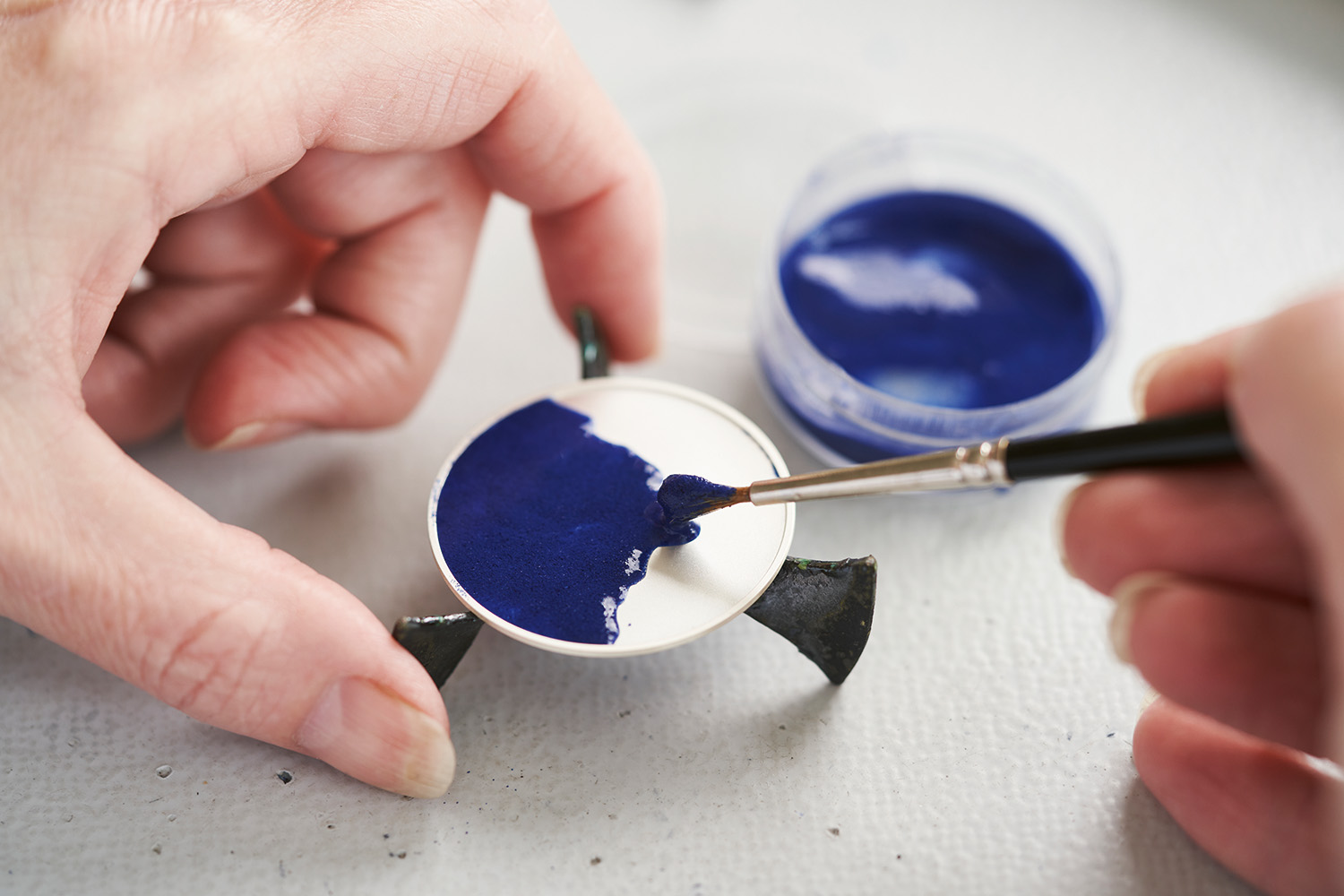
Crafting enamel dials demands significant human involvement as enamel layers are applied by hand before the firing process (Image: Ulysse Nardin)
Enamel, however, is a beautiful craft that many watch enthusiasts would love to own. Fortunately, there are techniques for larger scale production, but make no mistake, it’s far from industrial. Consider, for instance, the production of single-color dials, especially the white enamel dials. This process may involve the application of enamel powder through a sieve onto several baseplates simultaneously, typically made of copper. To prevent the powder from dispersing before reaching the oven, a layer of alcohol is applied on top, which ignites into a magnificent flame once the firing process begins.
COUNTER ENAMELING
Typically, the dial blank beneath the enamel is made of softer metals, such as precious metals or even copper. Due to the high temperature involved, both the enamel and baseplate may deform. To address this, enamelers add a layer of enamel on the back called “contre-émail,” or “counter enamel” in English. The counter enamel layer balances forces and helps control the expansion and contraction of the metal, ensuring that the dial blank with a counter enamel layer stays flat and prevents potential deformations like bending.
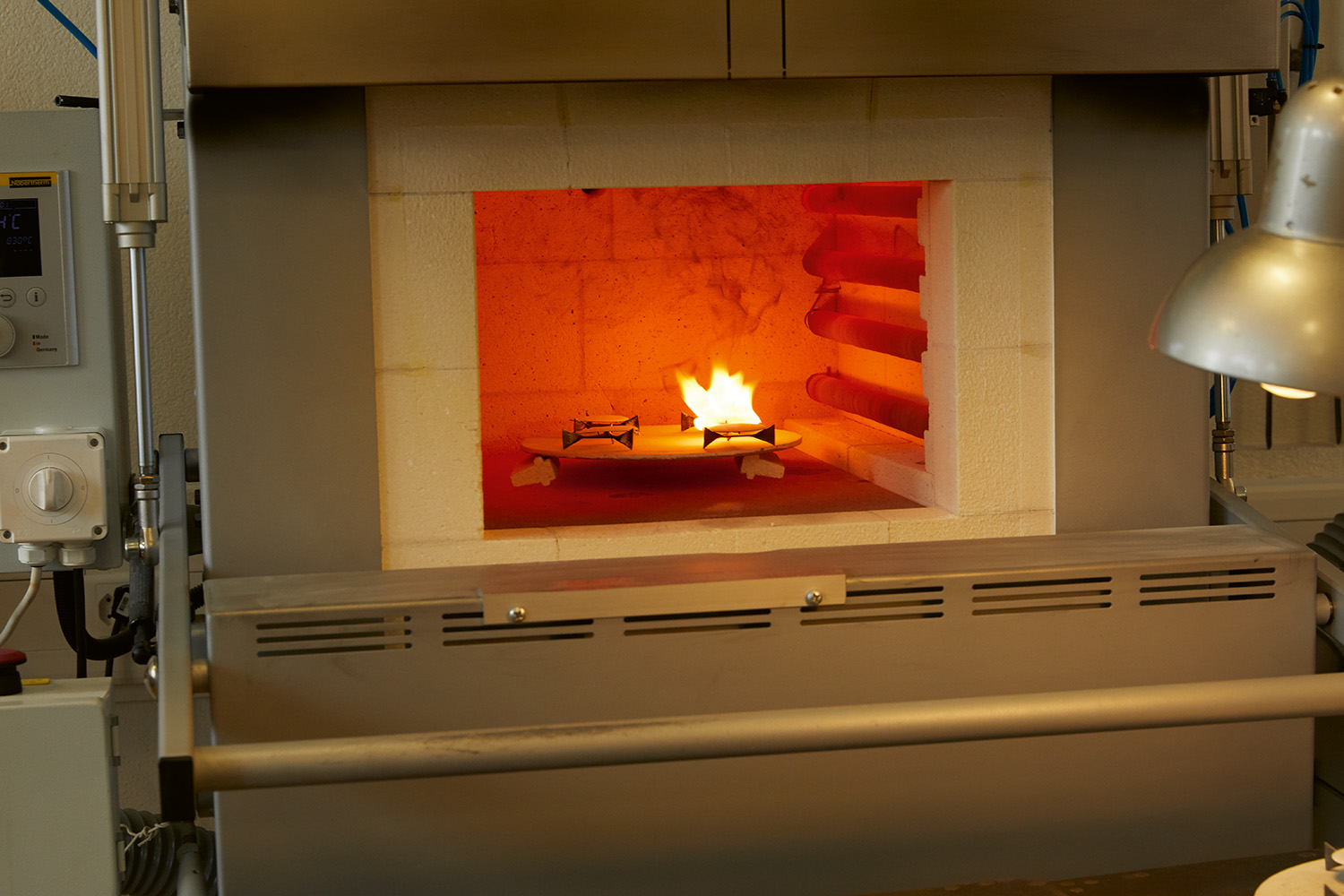
Captivating spectacle: Enamel dials ablaze in the oven at Donzé Cadrans
Nonetheless, certain watchmakers, such as Ferdinand Berthoud, opt for harder base materials like steel, eliminating the necessity for counter enameling. While this approach is considered innovative by some, others view it as a cost-effective option, recognizing that steel might not achieve the same enamel quality as gold, particularly with transparent or opalescent colors. On the other hand, there’s a contrasting perspective within the enameling community. Some argue that steel-based dials with opaque enamel can be just as beautiful as those based on gold.
POLISHING
In the enameling process, the enamel layers must undergo sanding, lapping or polishing. This preparation is crucial to ensure that defects, such as large air bubbles, are properly removed and to create a smooth surface for the application of the next enamel layer. Polishing is a delicate technique in the enameling process, with the required amount varying depending on the type of enamel dials. Single-color dials, for example, often demand more polishing. Both factories and independent artisans polish the enamel layers between firings to minimize imperfections, which would be noticeable on a monotonous background.
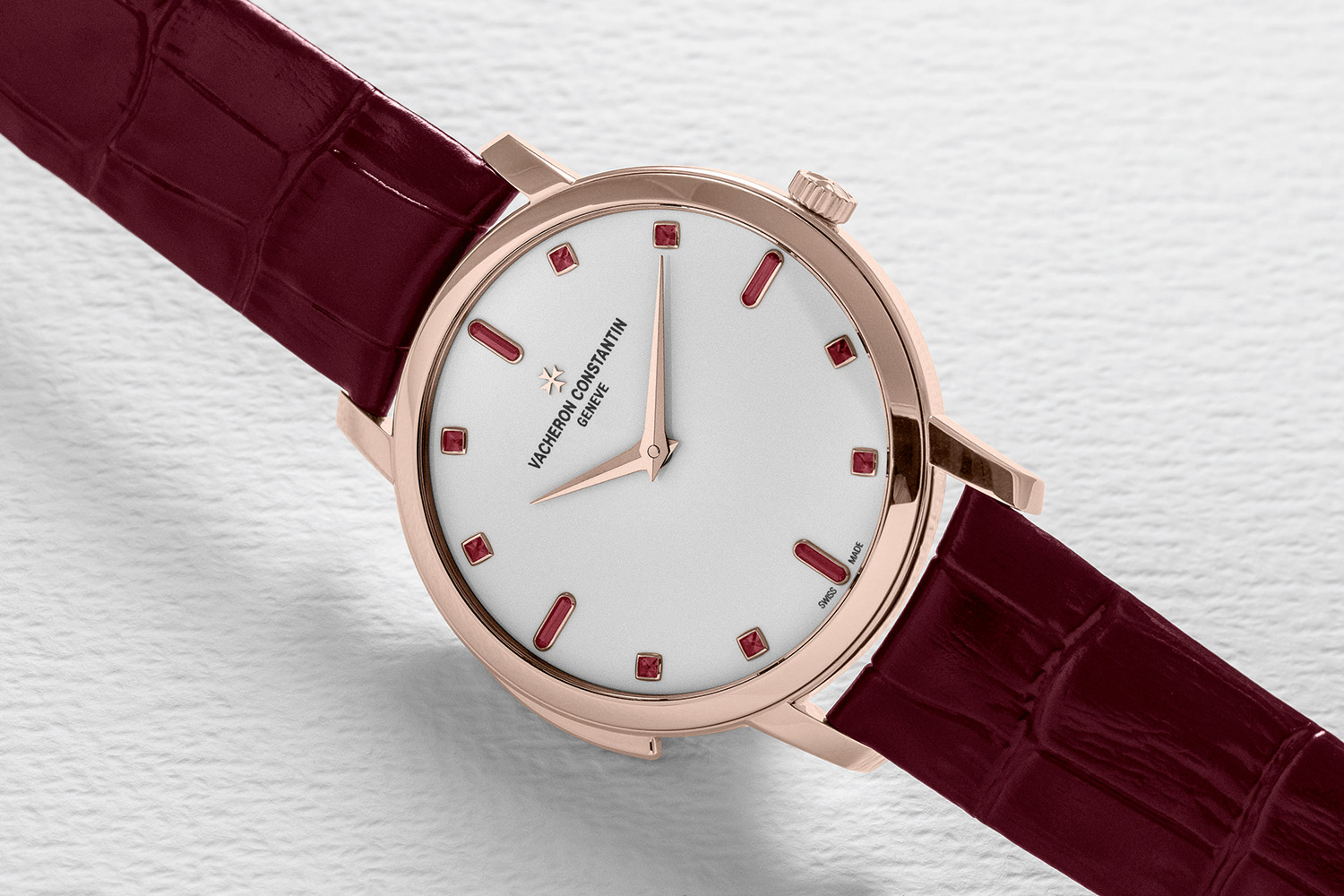
A modern Vacheron Constantin minute repeater with a cream enamel dial and ruby indexes
In factories, this polishing process is often performed by a machine, a technique referred to as lapping. In artisanal workshops, the polishing is done by hand, and enamelers note that it’s not always necessary to polish every single layer; it can be done every three to four layers of buildup. However, polishing a colorful cloisonné enamel dial is not always straightforward, as not all colors respond well to this process. Additionally, especially in artisanal workshops, the dial blank may feature raised edges, making it impossible to polish during the first few layers of enamel. Polishing becomes feasible only when the enamel has built up to the same level as or exceeds the raised edges of the blank. Notably, if defects such as cracks or air bubbles appear, the artisan can remove an entire layer and make any necessary touch-ups. It’s important to acknowledge that perfection does not exist in enameling. For instance, while excessive and aggressive air bubbles can be avoided, tiny air bubbles that are not visible from a distance are entirely natural, and dials with bubbles not visible to the naked eye are considered of good quality. In fact, they prove that the dial is genuine enamel and not lacquer.
APPLYING THE MARKERS
Lastly, in specific cases, the finished enamel dial may require the addition of hour and minute markers. This can be achieved either by hand painting enamel ink onto the dial or by pad printing enamel ink onto it. This step necessitates further firing to bond the enamel markers with the base enamel dial. Alternatively, the dial can also undergo pad printing with regular ink that does not require additional firing. If appliqué markers are necessary, holes will be drilled into the dial at this point. The appliqué markers will then be affixed to the dial with their bases extending through the holes from behind and folded, ensuring their secure attachment, similar to a typical dial. In short, the making of the enamel dial requires systematic preparation of the materials, multiple applications and finishing, allowing for the artisans or practitioners to make necessary adjustments in the process. This incremental approach is crucial for quality control, ensuring the creation of a perfectly crafted enamel dial that exudes warmth and beauty, destined to last for many years.
GRAND FEU ENAMEL AND ITS THRESHOLD FIRING TEMPERATURE
There is often a debate about the threshold firing temperature that qualifies an enamel dial as vitreous or grand feu enamel — the French term “grand feu” translates to “great fire” in English. All genuine enamel dials, regardless of their type, such as cloisonné, miniature painting or flinqué, are considered vitreous or grand feu enamel if they undergo the proper firing process. Authentic grand feu firings require high temperatures to facilitate sintering or vitrification.
This involves melting the enamel substance and fusing it onto the baseplate to create a glass-like or vitreous effect. Dials fired at lower temperatures may result in a less refined final product and lack the distinctive sheen that truly defines a high quality enamel dial. When consulting industrial experts about the minimum firing temperature that qualifies as enamel, the enamel workshop of anOrdain notes that it typically exceeds 800 degrees Celsius. Enameler Gabriel Colliard points out that firing temperatures can range from 720 to 850 degrees Celsius, particularly when working with red enamel. In summary, rounding the numbers, we can consider 800 degrees Celsius as a simplified approximation.
However, Ulysse Nardin, the owner of the enamel dial specialist Donzé Cadrans, presents a more legally binding viewpoint. As highlighted by Donzé Cadrans, Decree No. 82-223 of February 25, 1982, in French national law, specifies the following: Article 1: The names Email or Emaux are reserved for vitrifiable products resulting from the melting, vitrification or sintering of a substance made of mineral matter. These products are intended to form in one or more layers a vitrified coating, melted at a temperature of at least 500 degrees Celsius. Article 2: It is prohibited to manufacture, display, hold for sale, offer for sale, sell or distribute for free under the names Email or Emaux, with or without a qualifier, and to designate, by a name containing these words, products that do not meet the definition mentioned in Article 1.
VARIETIES OF ENAMEL DIALS
Stepping beyond the basic grand feu enamel dial, enameling offers a wide range of techniques that allow artisans to express their artistry. These techniques include cloisonné, champlevé, flinqué, paillonné, grisaille, and many more. We’ll explain them one by one now.
MONOCHROME ENAMEL
The simplest form of an enamel dial consists of vitreous or grand feu enamel in a single color across the entire dial. While this may sound straightforward, there are nuances to consider. The reason is quite simple: a large dial with a single color leaves no room to conceal imperfections. In particular, creating a black enamel dial is one of the most challenging tasks. That’s why some high-end watches opt for a simple, black enamel dial instead of a complex enamel painting. Despite its deceptively simple appearance, it speaks volumes about craftsmanship. For instance, the Patek Philippe Grande Sonnerie ref. 6301P boasts a black enamel dial with a deep, lustrous finish.
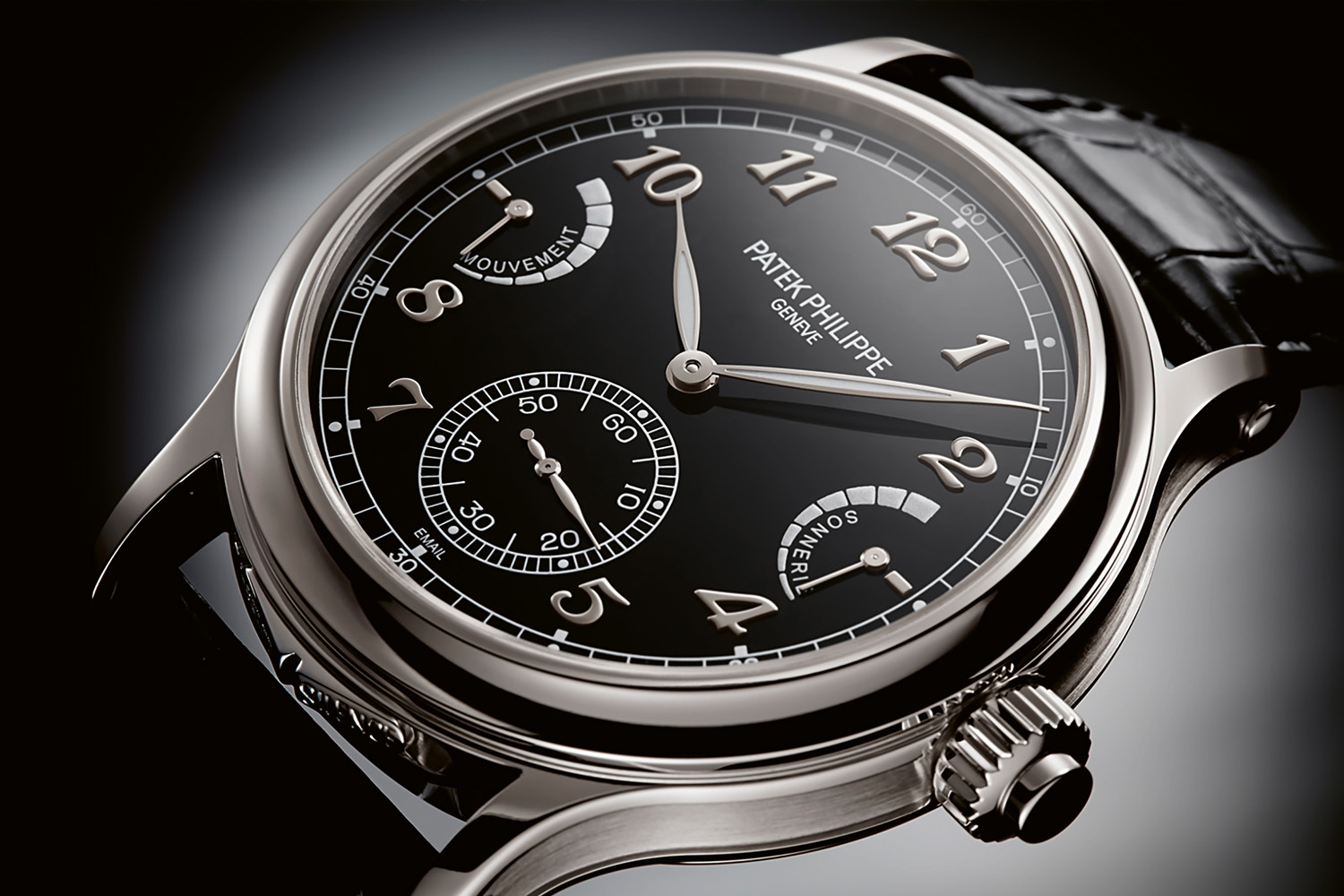
The Patek Philippe Grande Sonnerie ref. 6301P with a jet-black enamel dial
One crucial technique for crafting an immaculate enamel dial is the mirror-polish technique. This method involves carefully polishing the enamel to achieve a brilliant shine reminiscent of a mirror’s surface. To accomplish this, enamel paint is applied in extremely thin layers. With each firing, the dial is meticulously touched up before applying another layer and undergoing firing. The polishing process is tedious and repetitive because it reveals any air bubbles trapped in the enamel. In such cases, a diamond burr is used to remove them, and polishing continues afterward. Mr. Colliard notes that a piece can undergo firing and polishing up to a hundred times. He also mentions that 10 to 20 percent of the time is spent on firing, while the rest is dedicated to polishing — underscoring the craftsmanship required to create a monochromatic dial. While this technique can be applied to various colors of solid-color enamel dials, it finds its perfect application on black dials. It is now widely acknowledged that achieving an intense, deep and flawlessly uniform black enamel, free from defects like air bubbles, presents the greatest challenge in creating monochrome grand feu enamel dials. Mr. Colliard highlights that this technique is arguably the most demanding in enameling, while miniature enamel painting, as we will discuss later, is the most complex.
CLOISONNÉ ENAMEL
Thanks to the abundance of vintage watches with illustrated enamel dials from the mid-20th century and the current resurgence of world time wristwatches, cloisonné has become the most renowned enamel technique in watchmaking. Interestingly, it is also the oldest enameling technique, predating the advent of mechanical watchmaking by millennia. While the exact origin of enameling is still a subject of debate, scholars agree that the earliest artifacts of enameling can be traced back to Mycenae around 1425 B.C., which is almost 3,500 years ago from today. Additionally, significant findings have emerged from Cyprus, including the Kouklia gold rings from 1400 B.C. and the Kourion golden royal scepter from 1200 B.C.. These art pieces feature colored enamels accurately arranged in small metallic cells, employing a technique that would later be identified as cloisonné.
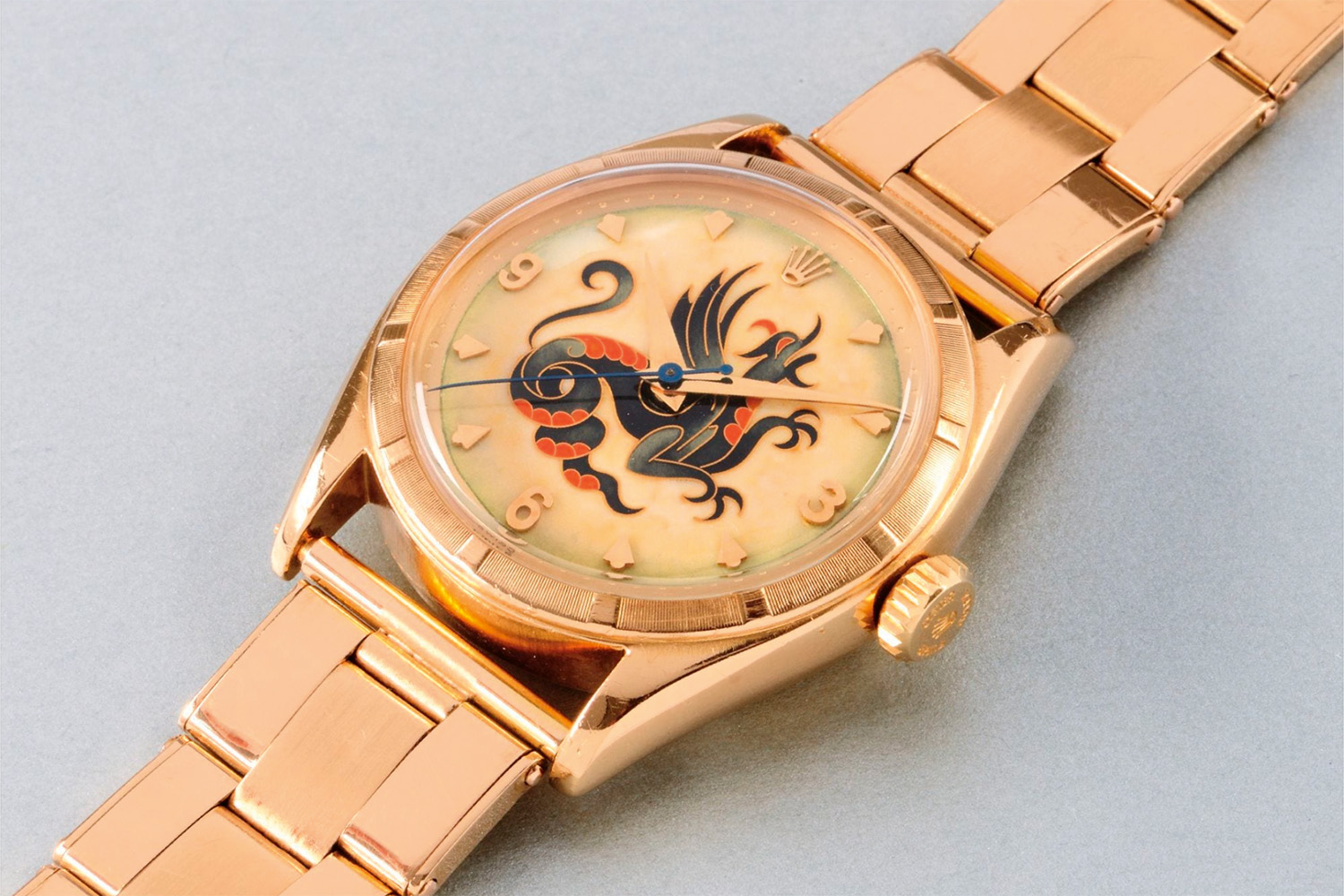
A vintage Rolex ref. 6085, circa 1952, with a cloisonné enamel dial depicting a dragon
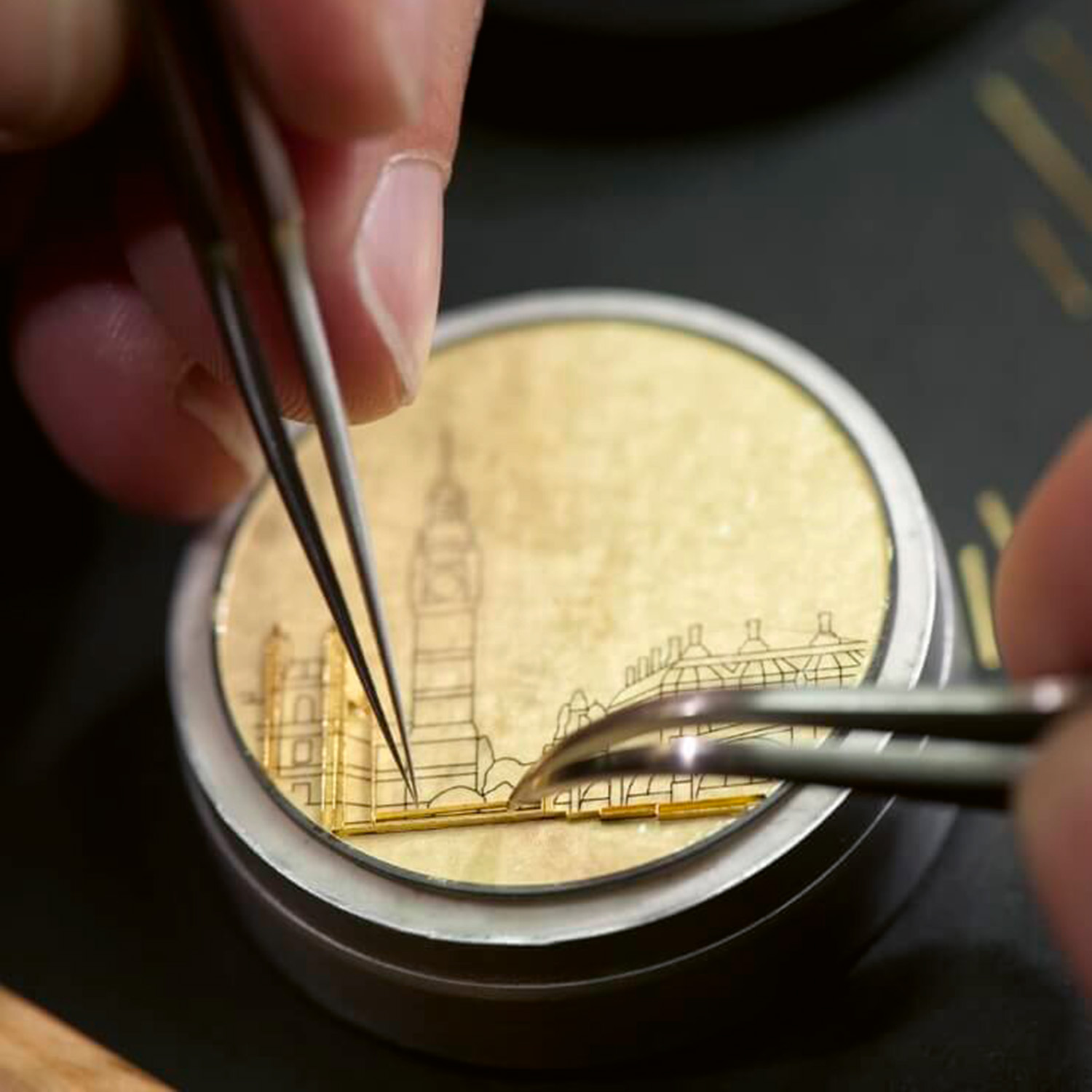
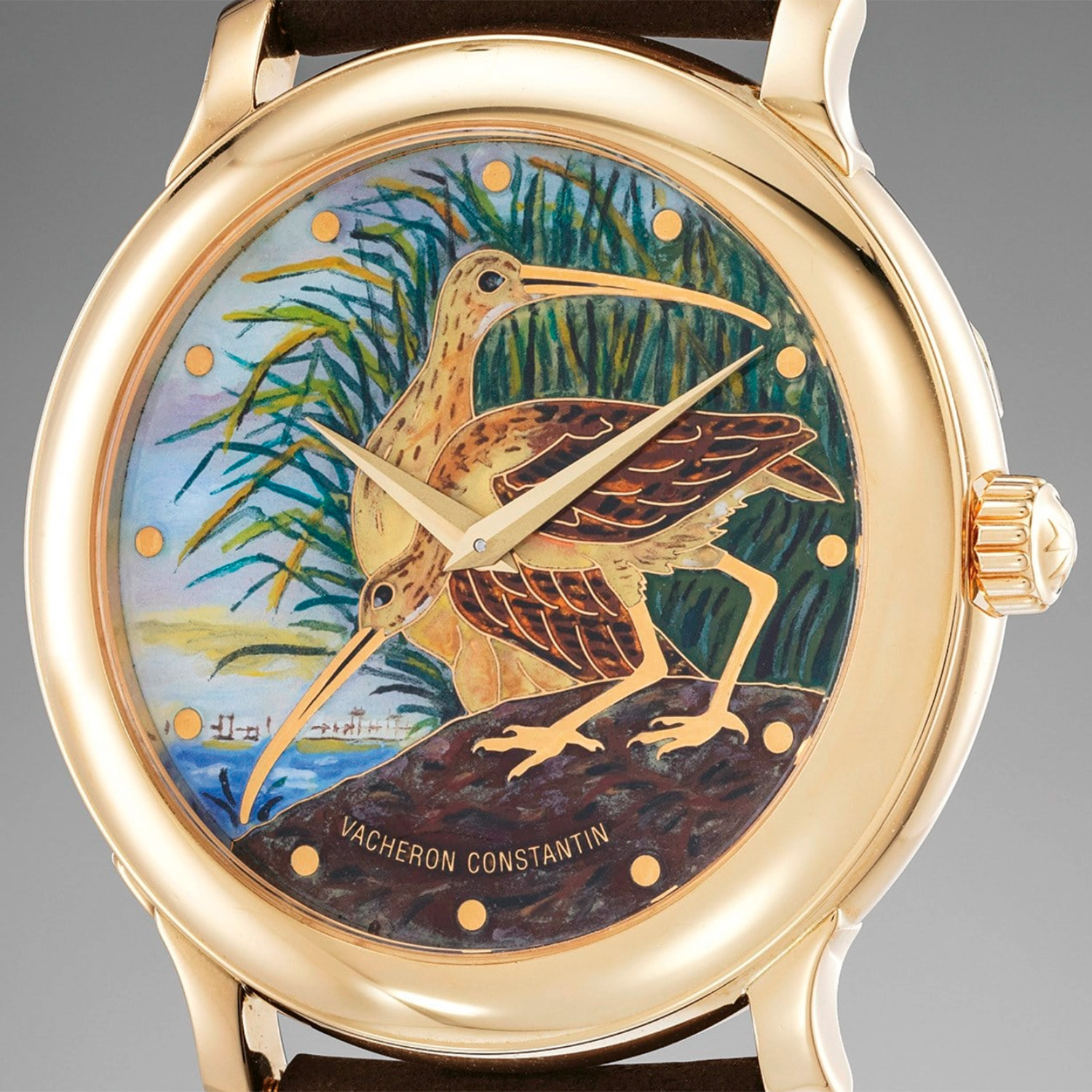
Cloisonné enamel is a technique that involves creating shapes or illustrations by carefully bending thin gold wires. These gold wires are delicately attached to the dial, forming small compartments or cells. Once these cells are in place, they are filled with colorful enamel to create intricate patterns or pictures. In today’s world, the cloisonné enamel technique is most renowned for its application in the creation of world time wristwatches featuring a map in the center. However, it’s crucial to note that cloisonné enamel dials can be employed in more artistic and creative ways to depict beautiful images, as exemplified below by Vacheron Constantin.
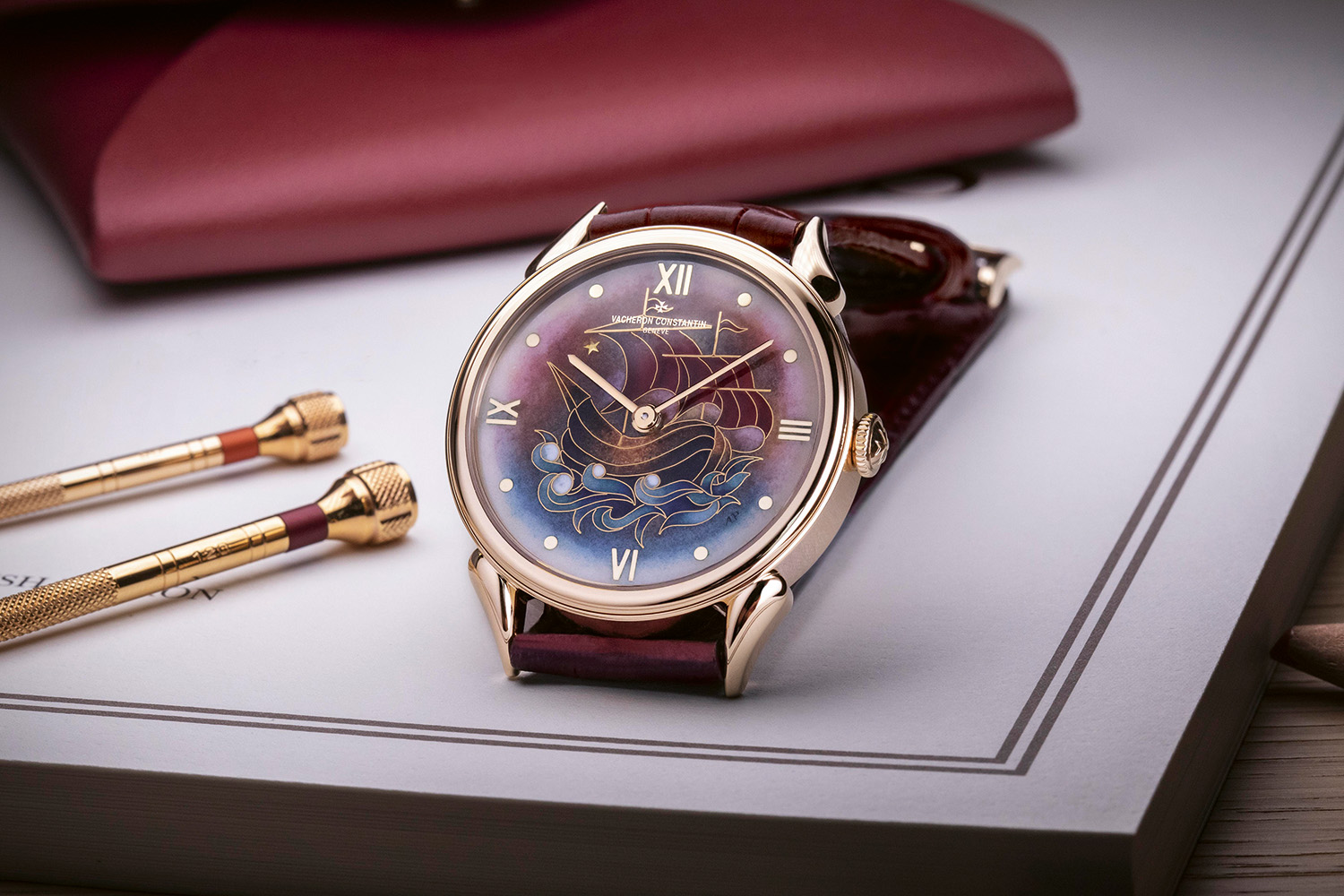
The Vacheron Constantin La Caravelle is a modern wristwatch with a dial that draws clear inspiration from the elegant designs of the 1950s. This one-of-a-kind creation was completed in collaboration with the renowned workshop of Anita Porchet
CHAMPLEVÉ ENAMEL
Like cloisonné enamel, which combines enameling and wireframing, champlevé enamel is the combination of enameling and another craft — in this case, engraving. It necessitates the collaboration of two artisans: an engraver and an enameler. The engraving can be done in negative; for example, a painting is carved into a dial and enamel is used to fill the cavity. Alternatively, it can be done in relief, where the main parts are relief engraved and enamel is used to fill the rest.
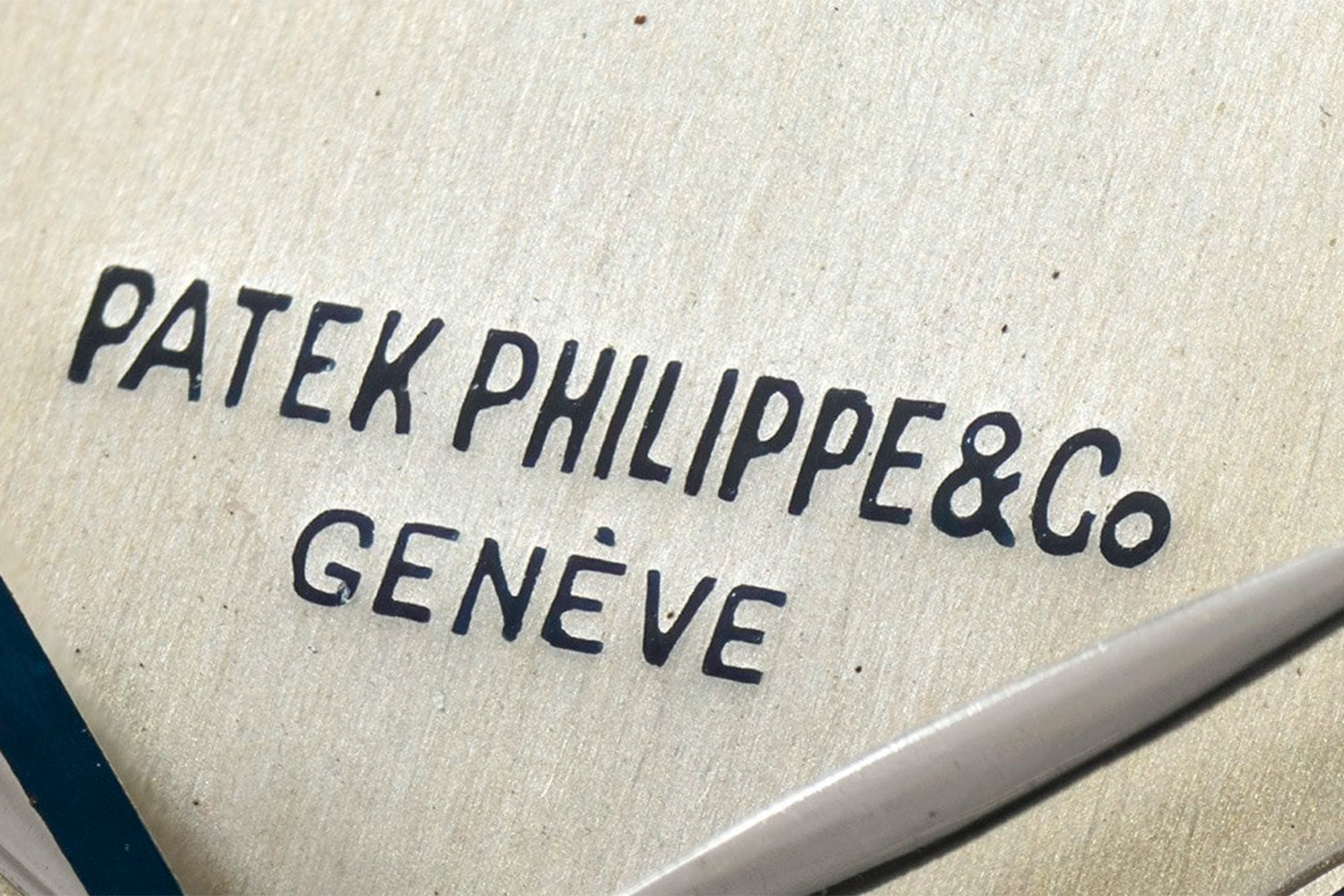
The champlevé enamel lettering and hour markers on the platinum Patek Philippe ref. 1579, once owned by Jean-Claude Biver (Image: Phillips)
One notable application of the champlevé enamel technique is the writing of a brand’s logo and scales on the dial, a technique that was frequently practiced until around the 1970s. This involves engraving a metal dial to carve out the letterings for the brand, as well as the hour and minute tracks, before filling them with enamel and firing it. The result is slightly raised above the dial and gives the scale and logo a subtle, three-dimensional look, adding depth to the dial that is perceptible to the eyes but often too subtle to be put into words, unless it’s observed by connoisseurs. Vintage watches with champlevé enamel letterings are highly valued by seasoned collectors, but they are challenging to find as restoration often leads to the flattening of the enamel.
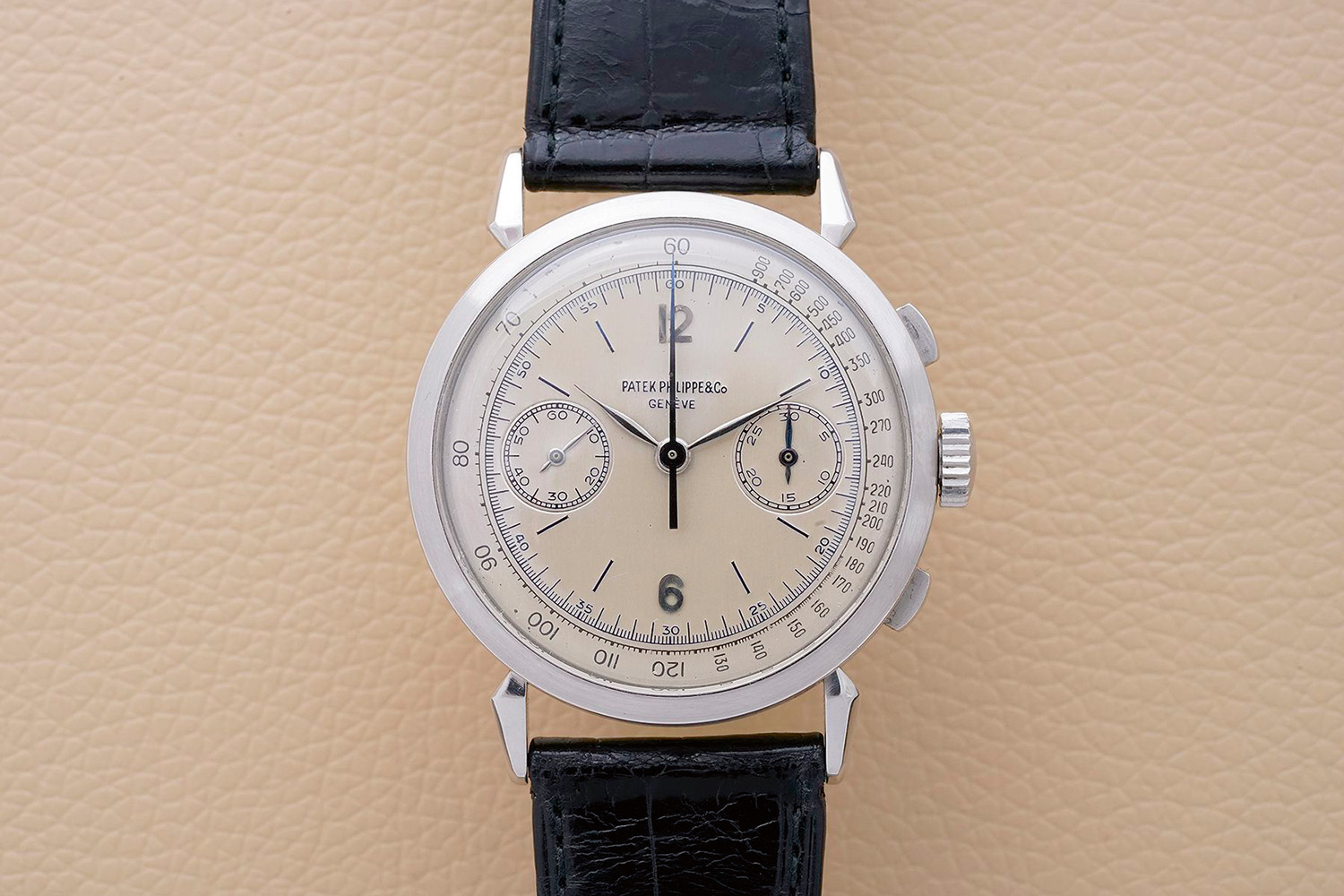
The full view of the ref. 1579, one of only three examples known in platinum
FLINQUÉ ENAMEL
Another common expression of enamel is through the flinqué technique, which combines guilloché and enamel. In this process, the dial is first created with a repeated engraving pattern called a guilloché. Flinqué is the art of creating these geometrical patterns, which can be accomplished in three ways: traditional engine turning, CNC engraving, or hard stamping. Once the pattern is formed, layers of translucent enamel are applied to the dial. The choice of translucent enamel is essential to maintain visibility of the guilloché pattern underneath, contrasting with opaque enamel. It is worth noting that the color of the baseplate will impact the final result. As a result, baseplates that undergo significant or uneven color changes when exposed to high temperatures are not suitable. Therefore, selecting the appropriate baseplate material becomes a critical decision in the flinqué technique.
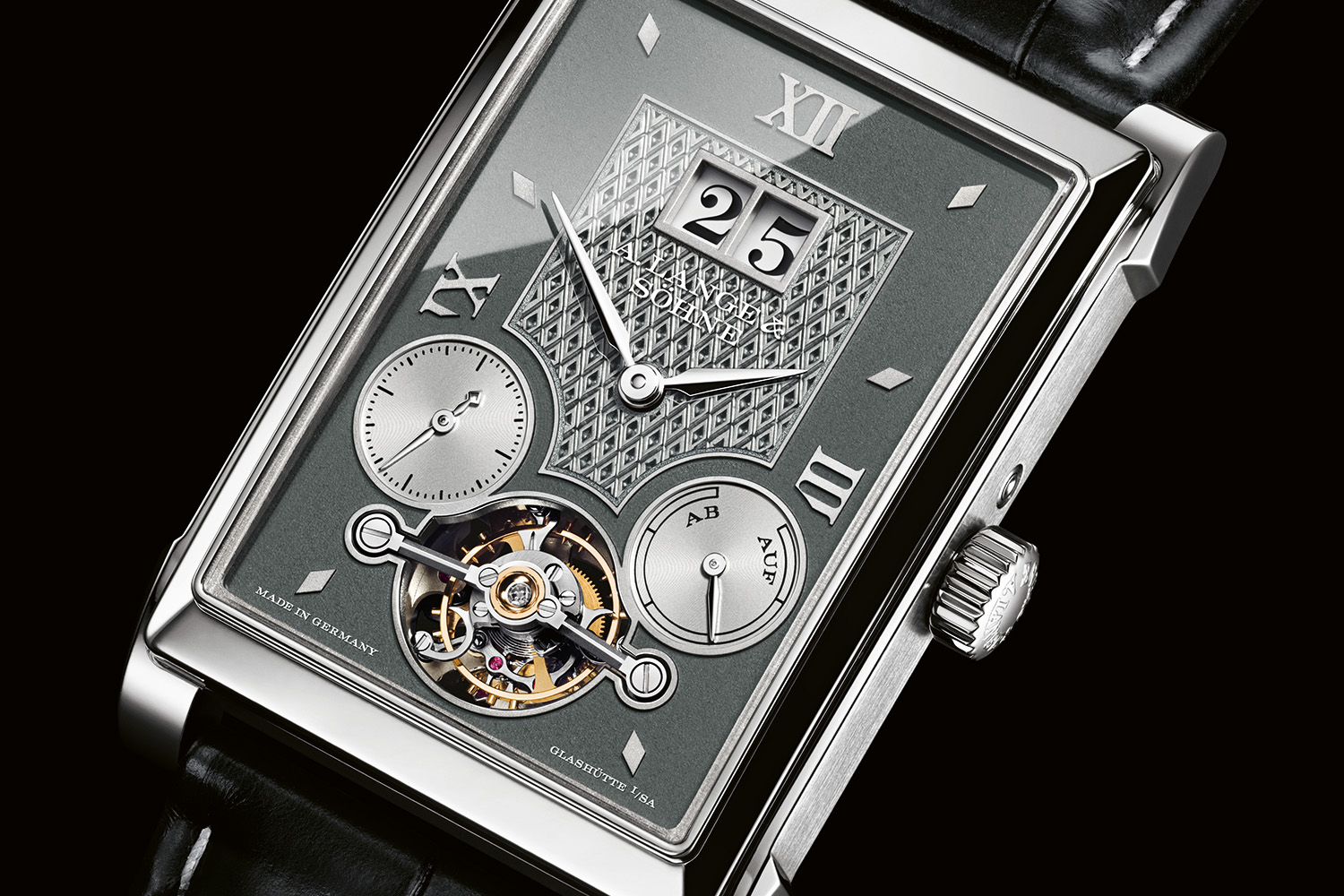
The dial has been engraved to create the hour markers in relief before being filled with enamel (Image: A. Lange & Söhne)
PAILLONNÉ ENAMEL
A less common technique, paillonné enamel, is a decorative enamel technique that involves the delicate application of metal foil onto an enameled surface. The word “paillonné” originates from the French term “paillons,” which means thin metal leaf. To create paillonné enamel, small decorative motifs or shapes, such as flowers, are cut from thin metal foils, typically made of gold or silver. These metal foils are creatively placed onto the surface of the object to be enameled, and transparent or translucent enamel is applied to secure the decorations. In some cases, paillonné enamel can also be applied in a more freeform manner, where the metal flakes have organic shapes and are sprinkled onto the surface in an organic pattern. Paillonné enamel is often used in combination with other enamel techniques, such as miniature painting or cloisonné enamel, to enhance specific areas and create focal points within the design, rather than being the dominant feature.
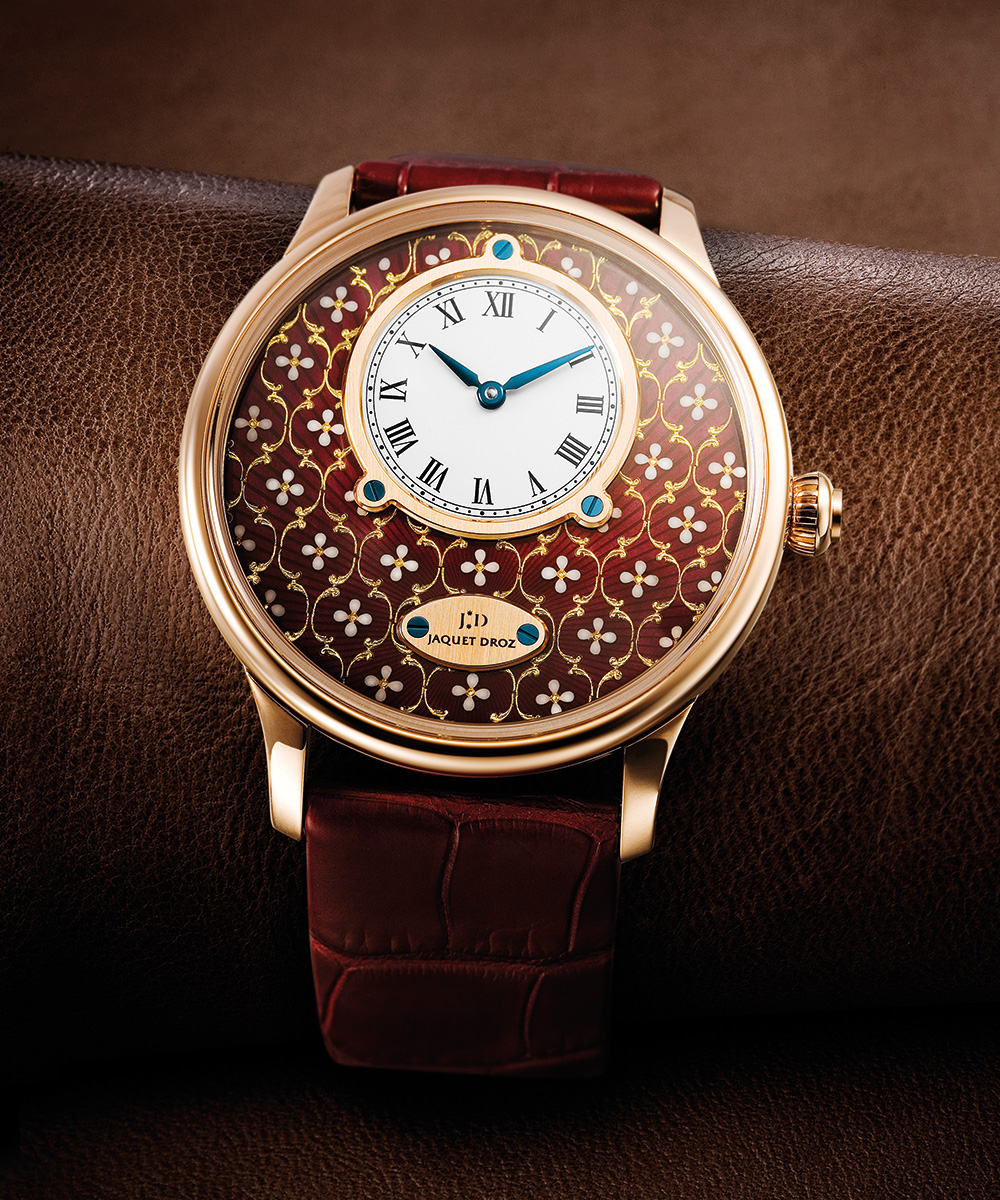
A demonstration of the effect of paillonné enameling with the Jaquet Droz Only Watch 2015 edition
MINIATURE ENAMEL PAINTING
Similar to cloisonné enamel, miniature enamel painting is celebrated for its intricate artwork. However, unlike cloisonné, miniature enamel offers artists greater creative freedom. Painters aren’t confined by wireframes; they can apply brushstrokes, adjust outlines and emphasize details during the painting process, departing from the pixelated impressions often associated with cloisonné enamel. For instance, miniature enamel painting serves as a canvas for enamelers to replicate famous artworks from the past. To delve deeper into the fascinating world of miniature enamel, we consulted expert enameler Gabriel Colliard, who shed light on the technique’s distinctive characteristics.

Crafting miniature enamel dials requires thorough planning of composition, colors and contrasts, as the hues evolve with each firing, demanding precision (Image: Gabriel Colliard)
From the very outset, miniature enamel differs from other enamel techniques due to differences in material composition. In miniature enamel, the raw materials contain more metal oxides than silica compared to standard enamel, where it’s the other way round. This variation results in a richer and more diverse color palette for creating artwork. Additionally, the ground enamel powder is mixed with essential oils, rather than water, before being applied to the dial. This mixture of colored oxides and oils creates a paste that provides artisans greater artistic freedom, akin to the flexibility enjoyed by painters working on a canvas. It enables the faithful replication of renowned artists’ works and fosters the creation of original artwork, thanks to its limitless range of nuances and expressive possibilities.
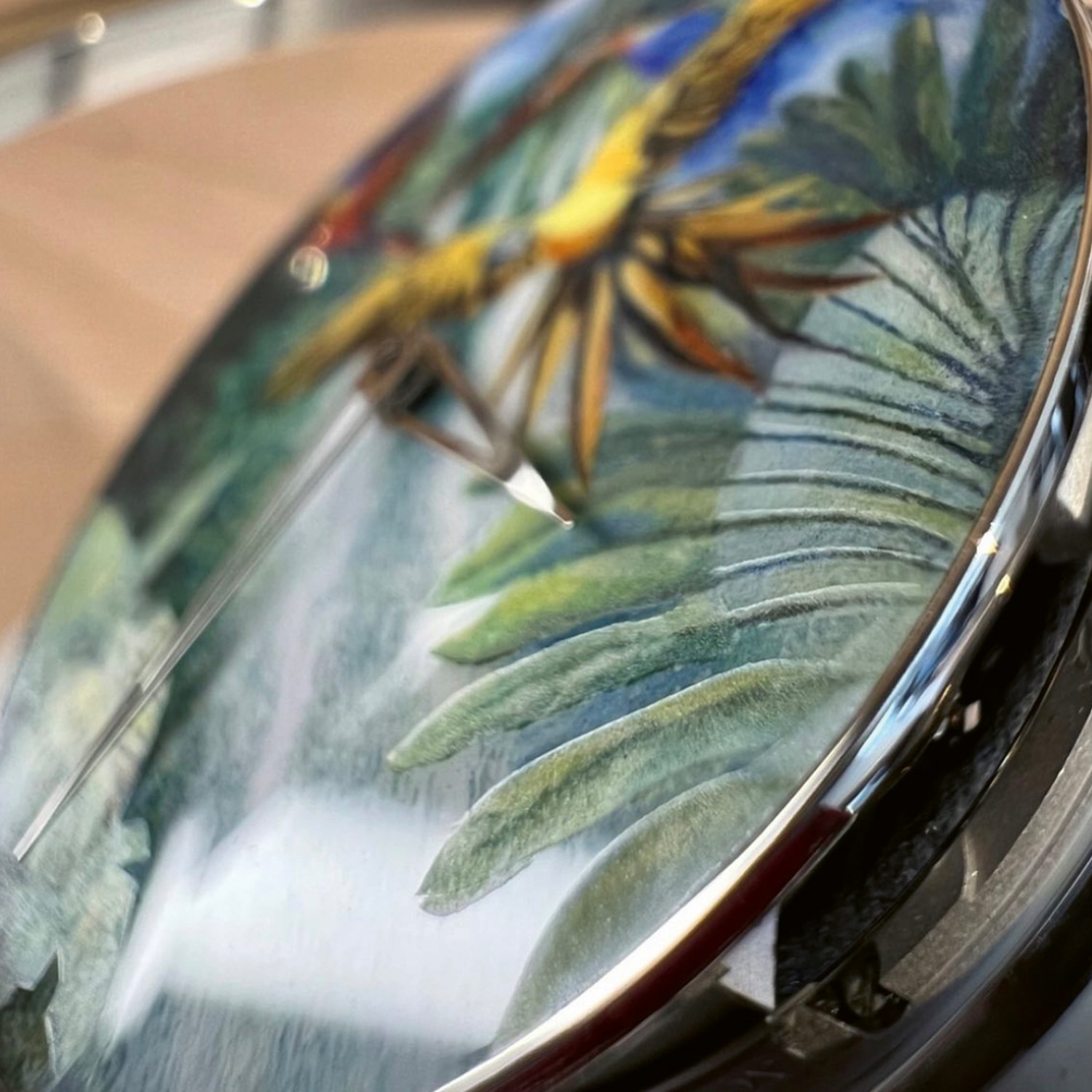
The finished dial with miniature enamel painting (Image: XRby)
Artists can employ a variety of brush techniques, including dots, short or long strokes, directional brushwork, or even Impressionist-style dabs. Each technique yields unique and expressive results that reflect the artist’s style. It’s important to note that achieving vibrant colors involves successive applications, followed by firings in the oven to intensify the hues. The end result is indeed a miniature masterpiece.
One important aspect of miniature enamel painting is the Geneva technique. This technique involves the application of an additional layer of fondant, a transparent and colorless enamel, on top of the completed artwork. When this layer melts during firing, it serves as a protective barrier, guarding the piece against potential damage and scratches. This protective step is particularly crucial for pocket watches or table clocks where the enamel is exposed on the exterior, unlike dials protected by a crystal cover.
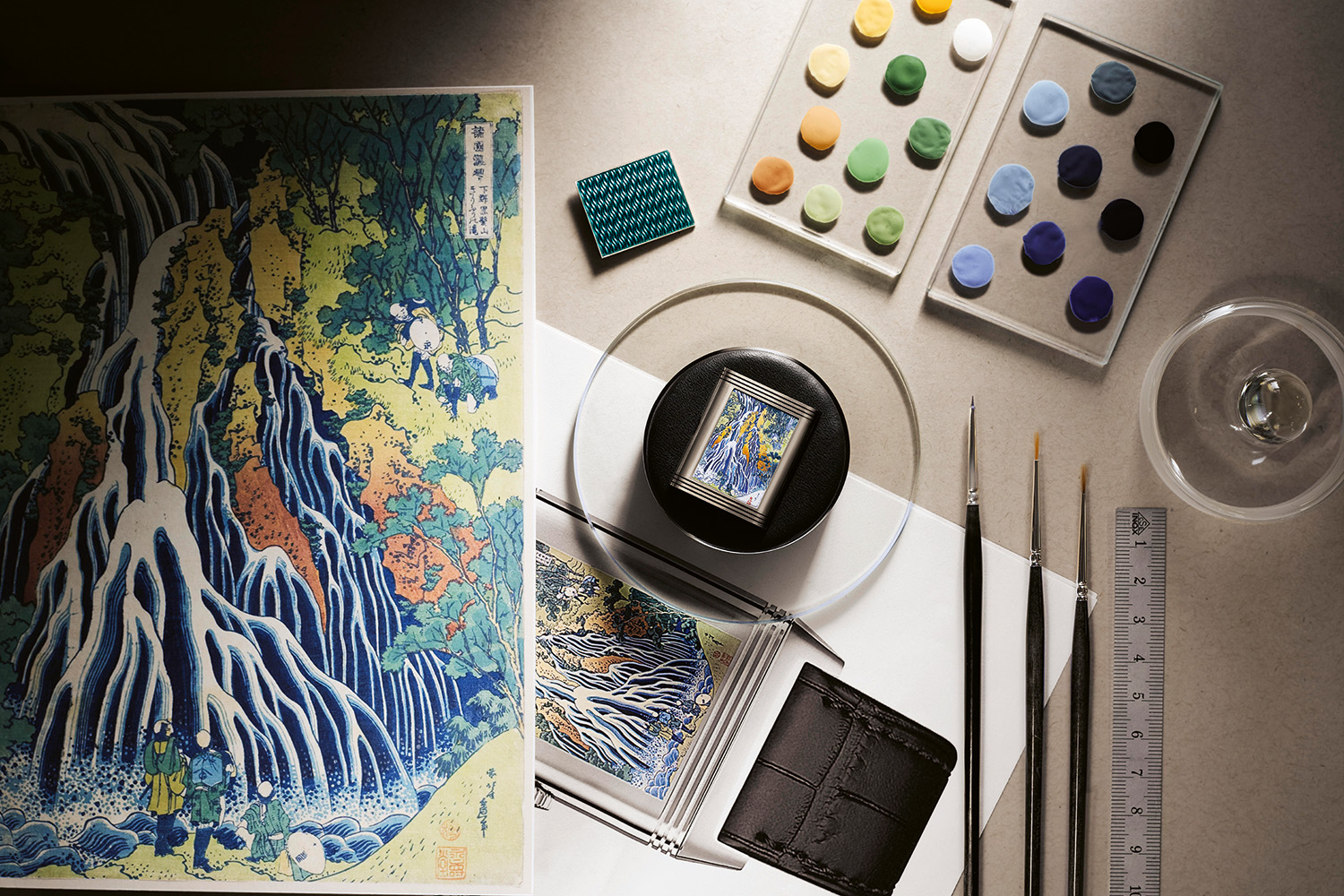
The artistry behind miniature painting on a watch dial (Image: Jaeger-LeCoultre)
In fact, the origin of fondant is to protect miniature enamel paintings on external surfaces, such as a pocket watch case. With a fondant layer on top of the enamel, even if it’s scratched to a minor extent, the fondant layer can still be polished to restore its former shine. Importantly, the fondant finish not only provides protection but also imparts a uniform and brilliant surface, a valued characteristic in the realm of watchmaking. Without a fondant layer, the different traces of brush strokes become evident, resulting in varying levels of shine. A fondant layer conceals these imperfections and gives the miniature painting a uniformly high quality finish. Today, the Geneva technique of applying a fondant layer has transitioned mainly from a practical necessity to an aesthetic choice.
GRISAILLE ENAMEL
Grisaille enamel is an uncommon technique in contemporary times. It is a subset of miniature enamel painting but adheres strictly to a monochromatic color scheme. The process begins with the creation of a dark base layer, typically using black, blue or gray enamel. Subsequent layers of lighter enamel are then applied on top, utilizing varying shades of the same color to construct the painting. Grisaille enamel showcases exemplary painting technique as it eschews the vibrant beauty of a colorful palette, emphasizing the play of light and shadow in a monotonous composition
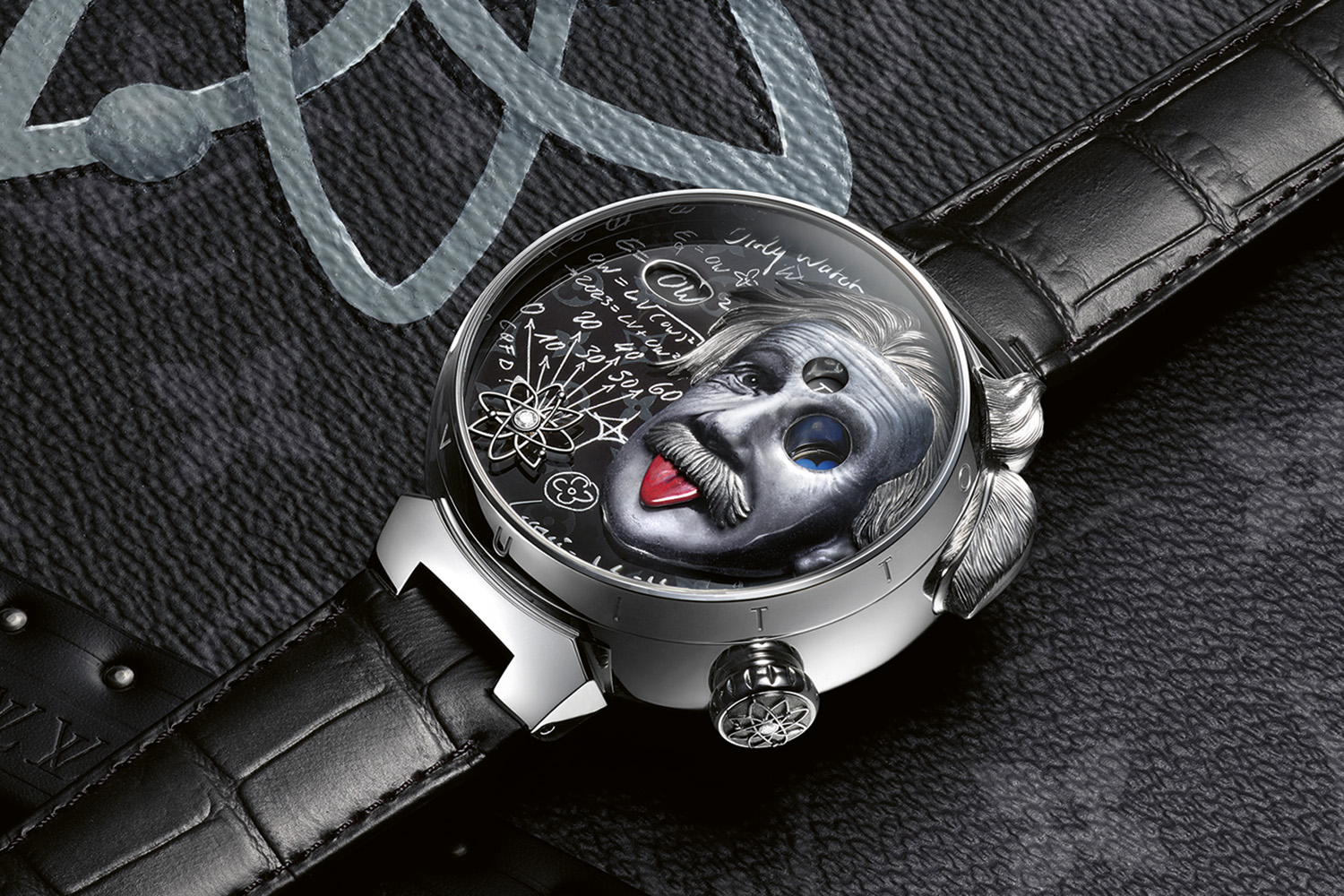
The Tambour Einstein Automata created for Only Watch 2023 (Image: Louis Vuitton)
PLIQUE-À-JOUR ENAMEL
An unconventional technique worth mentioning is pliqueà- jour, which shares similarities with cloisonné in that it involves coloring cells. However, unlike cloisonné, plique-àjour does not feature a solid metal dial. Instead, the enamel is carefully painted into hollow cells supported by a glass back temporarily, which is later removed after firing is complete. This technique produces translucent enamel that reveals what lies beneath it, such as the intricate mechanics of watches.
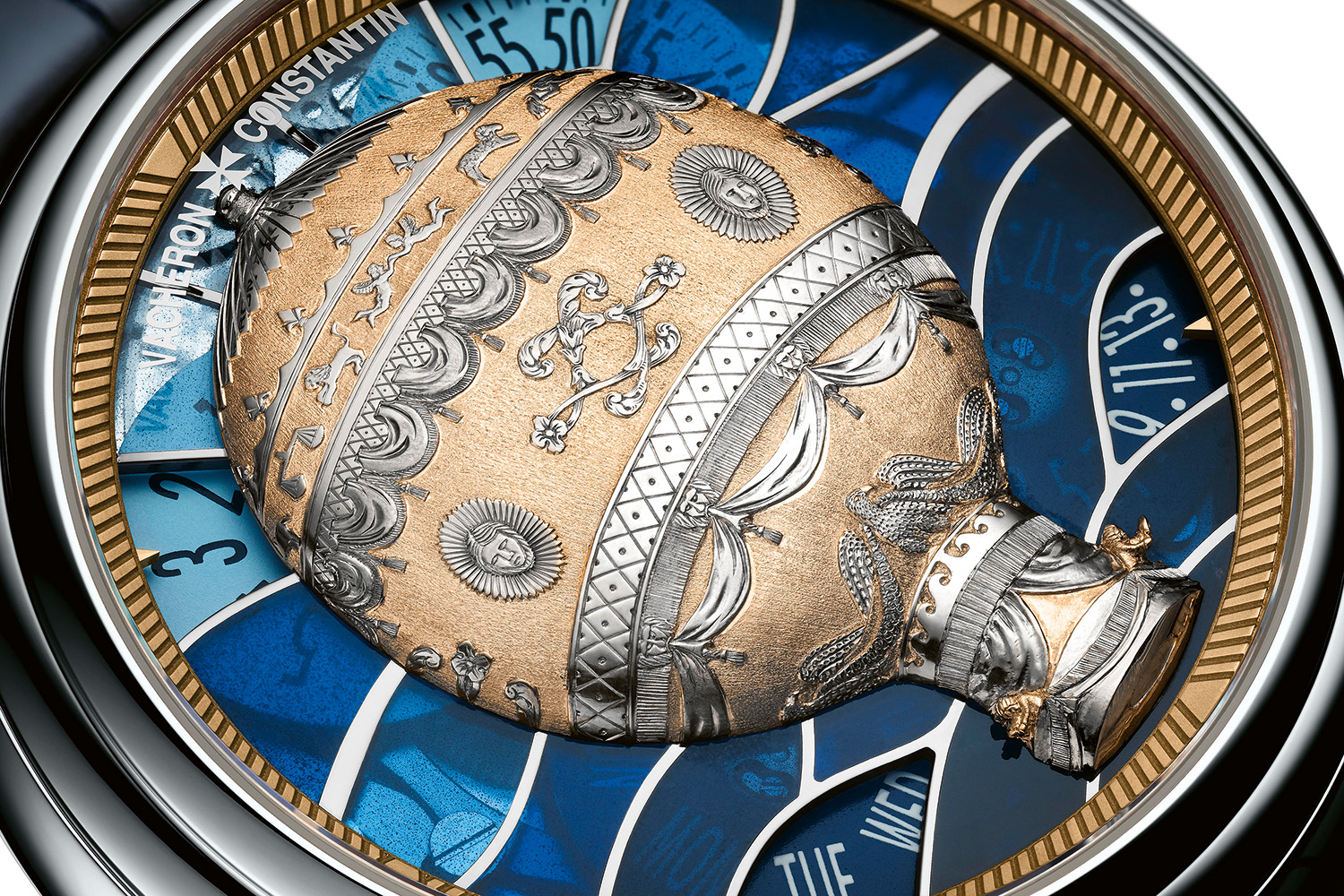
The Vacheron Constantin Métiers d’Art Les Aérostiers timepiece is an exquisite example of plique-à-jour enamel, revealing the quadruple rotating time-telling disks beneath its translucent enamel (Image: Vacheron Constantin)
NOTABLE ENAMELERS
There have been numerous exceptional enamelers throughout the past centuries, with notable names such as Jean-François-Victor Dupont, Carlo Poluzzi and Suzanne Rohr. However, many of these historical pieces were not signed by the artists, making it a scholarly endeavor to identify their works. Nevertheless, these masterpieces can be admired online or in museums, providing a source of free education in the beauty of enameling. In this section, our focus shifts to the contemporary era and the different producers of enamel dials. Currently, there are three main types of enamel dial producers. The first type are specialized dial making factories that solely focus on producing dials and supplying them to a range of watch brands. The second type are workshops within watchmaking manufactures. Prominent watchmakers like Patek Philippe and Vacheron Constantin have their own métiers d’art workshops capable of creating enamel dials in-house. The third type consists of small workshops led by renowned artists, such as Anita Porchet, who bring their expertise and artistic vision to the creation of enamel dials.
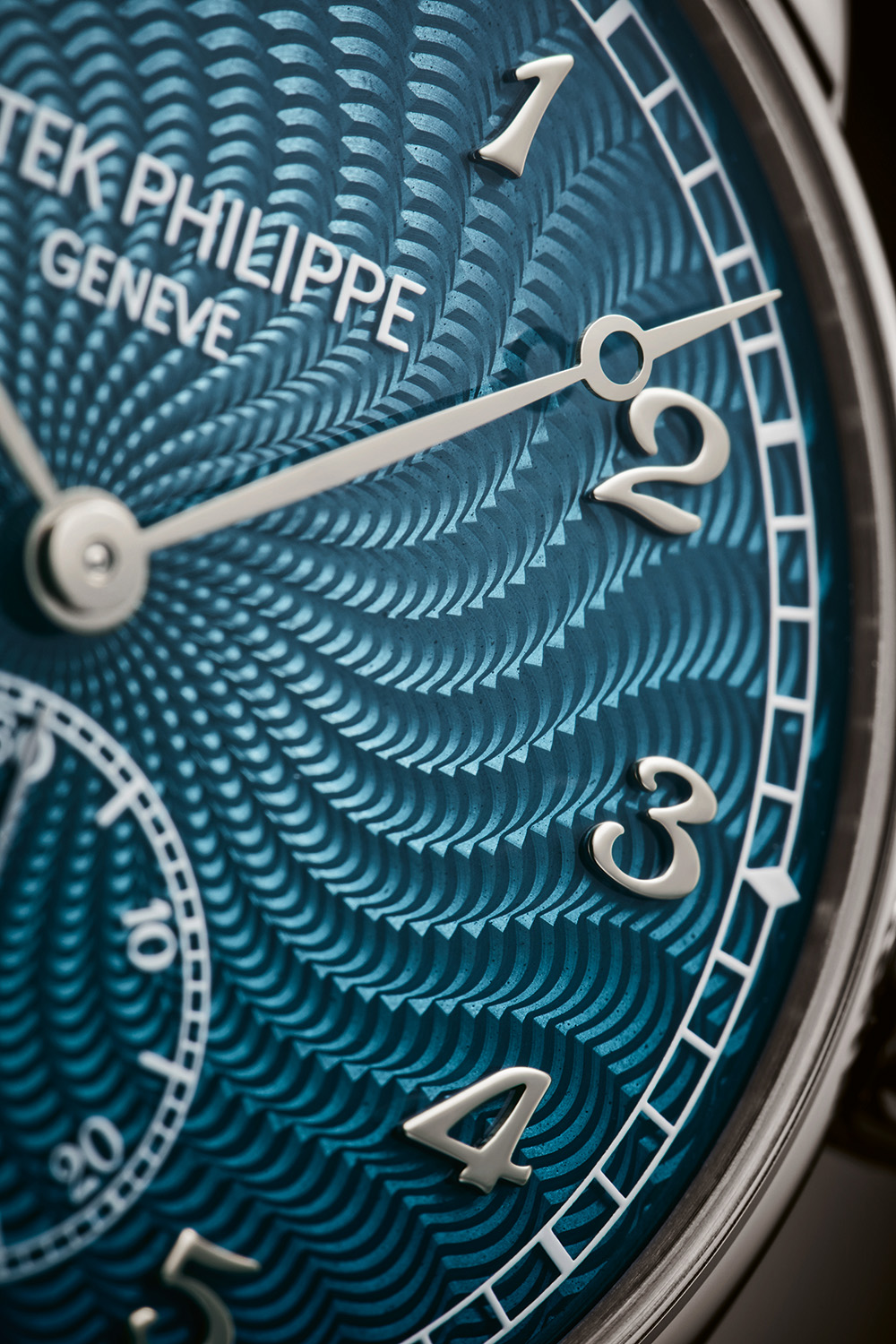
The Patek Philippe minute repeater ref. 5178G with a handmade guilloché enamel dial in blue
DIAL FACTORIES
Dial factories specializing in the production of enamel dials include Donzé Cadrans, which was established in 1972 and acquired by Ulysse Nardin in 2011. It produces a wide variety of enamel dials, from monochrome dials to artisanal cloisonné and champlevé enamel dials. What sets Donzé apart is its ability to balance quantity and quality, allowing it to supply various brands, including industry giants. This accomplishment is both meaningful and distinguishes them from small artisanal workshops. Other Swiss factories include Rubattel et Weyermann, founded in La Chaux-de-Fonds in 1890, became part of the Swatch Group in 2002. In Japan, Fuji Porcelain Enamel Co., Ltd. is a major manufacturer of enamelware, providing Seiko with enamel dials.
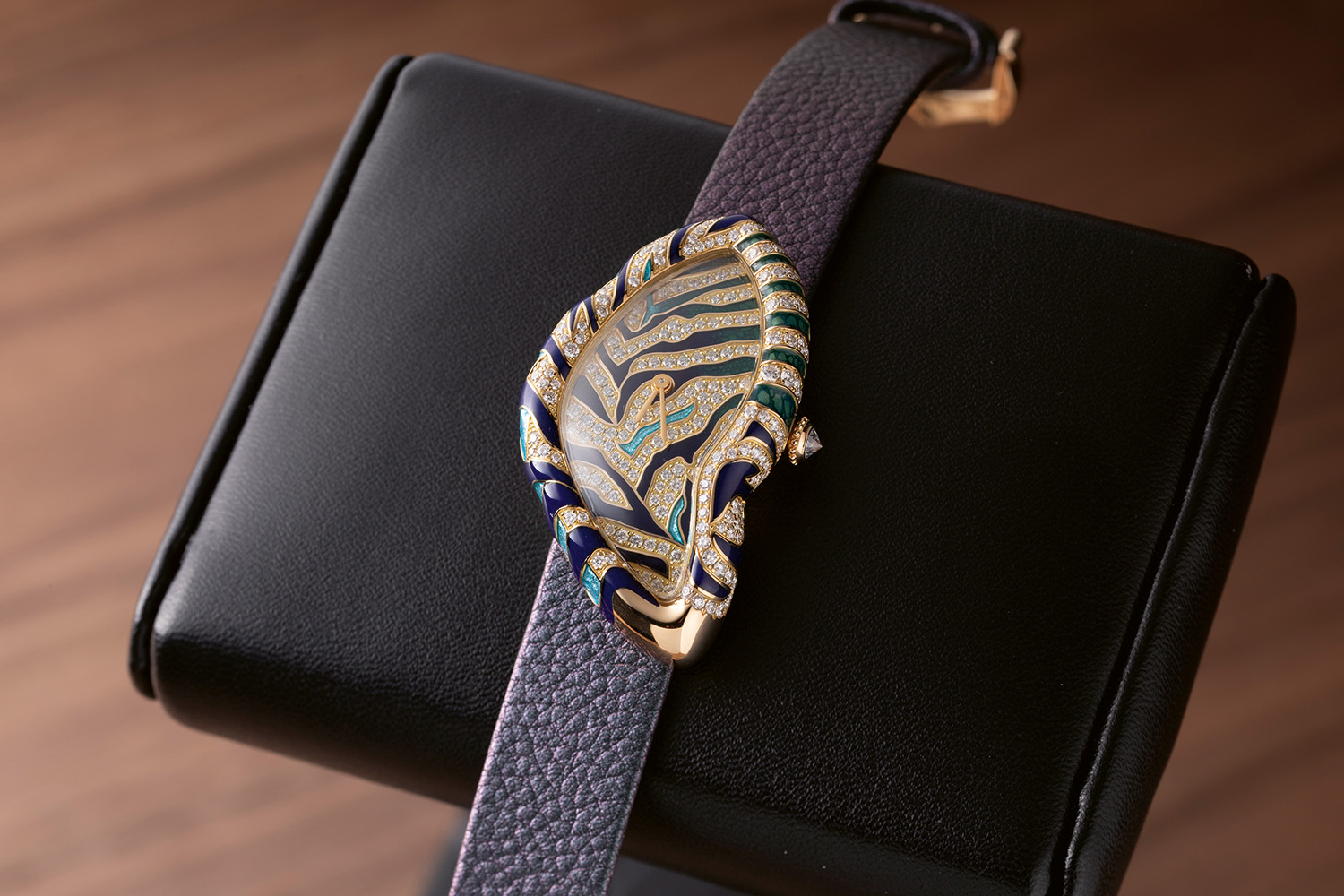
The Cartier Crash Tigrée with enameled stripes
Regarding the production of enamel dials in a factory setting, various processes are employed, some of which are naturally more industrial and scalable. For instance, enamel dials can be created on a large enamel sheet before being cut into individual disks. It’s important to note that enamel is not flawless, so dials cut from the same sheet may exhibit variations, including imperfections like spots. Companies grade and price these dials based on their complexity and workmanship. It is noteworthy that some enamel dials are not only budget-friendly, but also praised for their quality. Donzé, for instance, has acknowledged the remarkable enamel workmanship exhibited by both Seiko and anOrdain.
WATCHMAKING MANUFACTURES
The second category of enamel producers comprises watch brands equipped with their own enamel workshops. Notable examples include Patek Philippe, Vacheron Constantin, Jaeger-LeCoultre and Cartier. These brands boast specialized metiers d’art workshops capable of crafting enamel dials in-house. While today’s watchmaking world places significant emphasis on independent houses — many of which are truly deserving of recognition — it’s essential to acknowledge that watch brands also play a pivotal role in preserving the art of enameling. For example, Patek Philippe is renowned not only for the quality but also the quantity of enamel dials it produces in-house. This is especially evident in their annual introduction of limited quantity or unique pieces in the Rare Handcrafts collection. While Patek collaborates with independent enamelers, experts have remarked on the noteworthy quantity and high quality of enamel dials crafted within the brand.
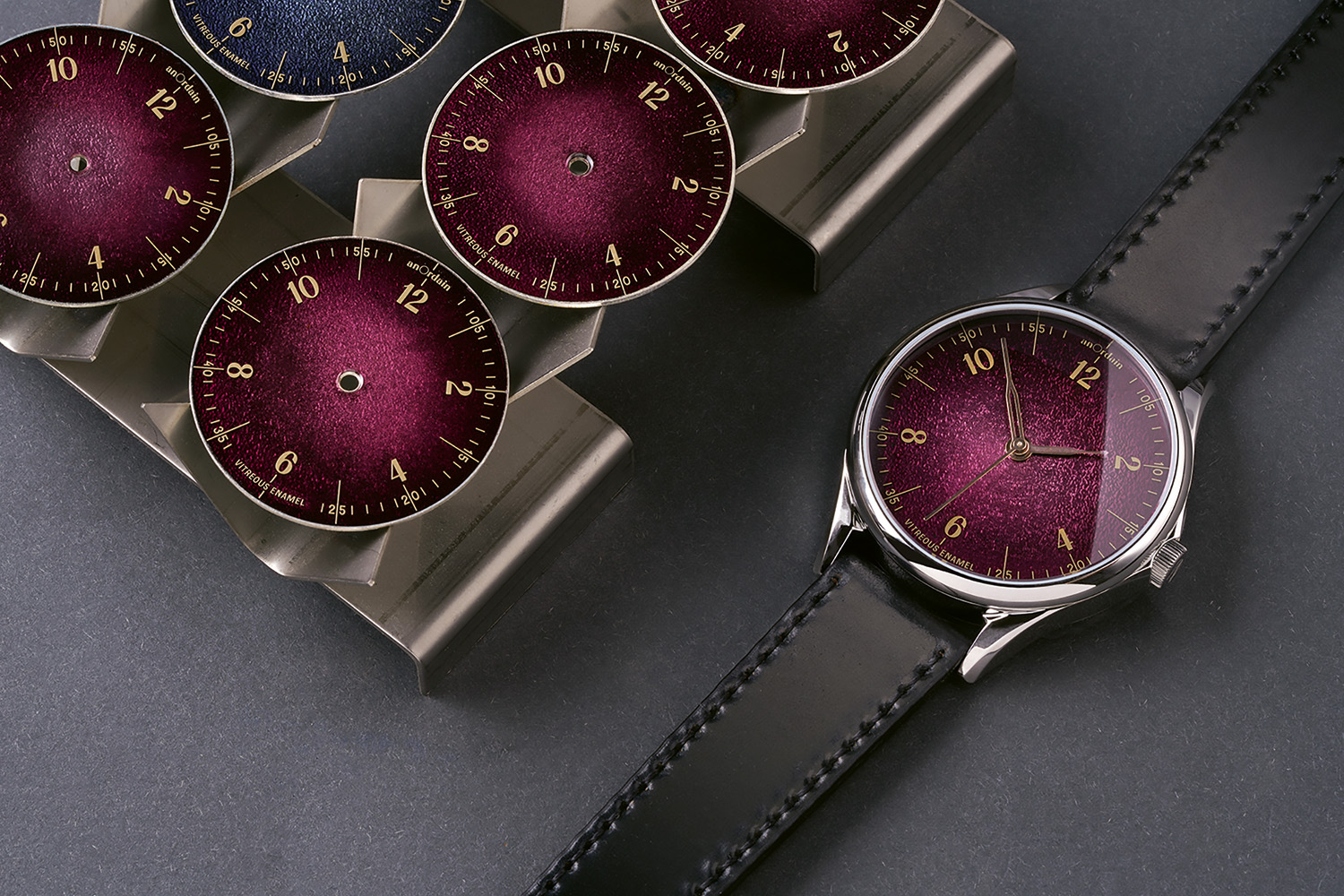
An unusual enamel dial in plum color with a fumé finish by anOrdain
Similarly, Vacheron Constantin houses a significant workshop, complete with a Métiers d’Art stable and a program for commissioning unique pieces. Jaeger- LeCoultre is celebrated for its tradition of miniatures on enamel, particularly within the iconic Reverso collection. Even fashion brands like Hermès and Louis Vuitton have made their mark in this aspect. These watchmaking houses play a vital role in the world of enameling. They pass down the know-how through training, ensuring a substantial production quantity to maintain continuous interest in enamel within the market. One notable example is Van Cleef & Arpels, which focuses on jewelry-oriented enamel and has the largest enameling workshop. It is also dedicated to training new enamelers.
It’s important to mention that some smaller brands are starting to make their own enamel dials. Take anOrdain, for instance. While they may not be in direct competition with the big brands we mentioned earlier, they’re significant because they offer straightforward and affordable enamel dials that a wider group of watch enthusiasts can enjoy. Furthermore, watchmaking brands engage in vital research efforts. Cartier, for instance, stands out with its ongoing research into new techniques in artistic crafts. These contributions help uphold the esteemed tradition of enamel craftsmanship and rightfully earn recognition for these watchmaking houses.
INDEPENDENT ARTISANS
Finally, there are small workshops led by master enamelers, dedicated to crafting the highest quality and most luxurious dials. One outstanding example is the workshop established by Anita Porchet, widely acclaimed as one of today’s foremost enamel artists. Trained under esteemed enamelers of the 20th century, including Suzanne Rohr, Anita’s workshop is highly sought after for collaborations with various high-end brands and independent watchmakers. Notable examples of their work include the Audemars Piguet Code 11.59 Grande Sonnerie Carillon Supersonnerie and the Vacheron Constantin Tribute to Johannes Vermeer pocket watch. They have also created numerous unique pieces for prestigious brands like Patek Philippe, Chanel and Hermès.
Another noteworthy independent enameler is Gabriel Colliard, renowned for producing high quality miniature paintings for top brands such as Patek Philippe, as well as for independent watchmakers like Ludovic Ballouard and Akrivia. One of Mr. Colliard’s latest works is the enamel dial of the platinum version of the Rexhep Rexhepi Chronomètre Contemporain II. At first glance, it may appear deceptively simple, with a vast expanse of black enamel, except for a small seconds register in gray enamel revealing the hand engraved gratte pattern. However, the dial’s flawless quality perfectly showcases Mr. Colliard’s artistic and technical prowess.
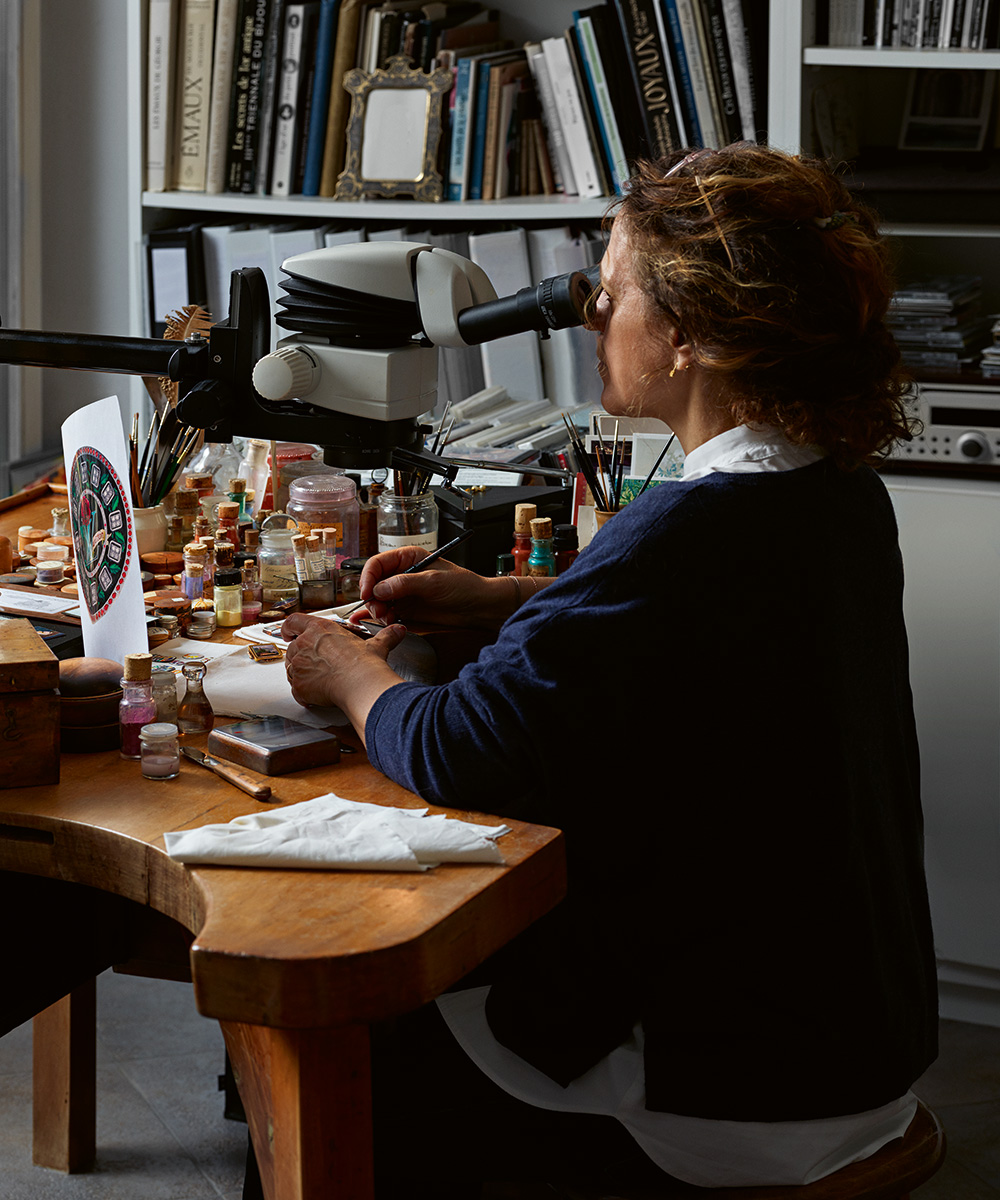
Anita Porchet (Image: Louis Vuitton)
FUTURE OF ENAMELING
With its centuries-old tradition, enameling stands as the pinnacle of dial artistry. In an era where technology often supplants craftsmanship, enamel remains one of the last dial making techniques, if not the only one, that relies on manual craftsmanship. While computer numerical control (CNC) machines attempt to mimic the intricate beauty of guilloché dials, there’s no technological substitute for the creation of enamel dials.
While concerns about the decline of enameling and the loss of secret techniques have been raised, this is not the case today. In the past, enamel craftsmanship lacked formal training, with knowledge passed down from one artisan to another. However, in the contemporary landscape, diploma programs are available in Limoges, France, and Barcelona, Spain, primarily focusing on jewelry applications or larger pieces. In Switzerland, courses like the Centre de Formation en Horlogerie (CFH)’s “Introduction to Enameling” program, a 68-hour course that includes watchmakingfocused specializations. However, these courses provide an overview of enameling, as the profession is typically refined through years of experience. Nowadays, continual enameling training is often conducted internally within watchmaking companies. Nevertheless, Donzé has pointed out that a challenge in the watch industry is that the demand for enamel is often not high enough to sustain in-house training; for instance, only two enamelers have successfully completed the course provided by Richemont in as many years.
Within smaller artisanal workshops, Mr. Colliard observes a notable shift towards transparency and the active sharing of knowledge. He notes, “Several enamelers are passionately passing on their knowledge to ensure its continuity among new generations.” In essence, a growing range of practitioners, from independent artisans to large manufacturers, are involved in practicing enameling while simultaneously training new artisans. This should help preserve the art of enamel, if not also contribute to making it more widely recognized and accessible.
it more widely recognized and accessible. Notably, while manual skill remains an integral part of enameling, strides have been made to enable larger quantities and faster production. The emerging techniques and technologies do not replace the beauty crafted by human hands, but they present an intriguing subject as they facilitate more stable production and larger quantities, ensuring that these exquisite creations can be part of more people’s lives.
One emerging technology, for example, involves the incorporation of laser engraving on enamel. By laser removing materials on the dial blank, it can create clear contours that replace the golden wires on a cloisonné enamel dial. Additionally, lasers can be used to finish the surface of enamel, giving it a matte sheen. Another new technology is the vacuum oven, which operates similarly to electric ovens but has the ability to absorb air during the firing process, thus reducing the size and number of air bubbles in enamel layers.
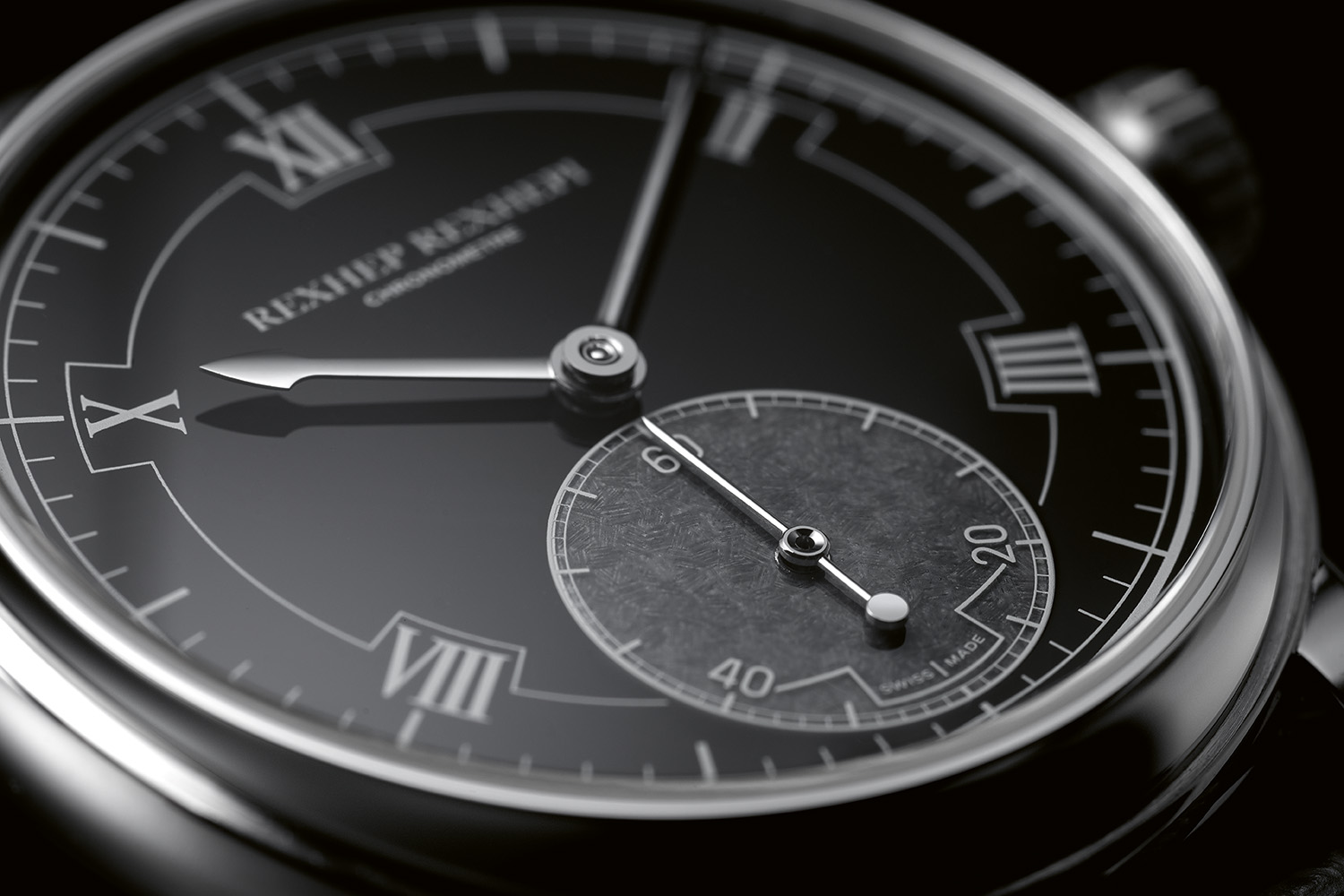
Rexhep Rexhepi Chronomètre Contemporain II in platinum, with a black enamal dial made by Gabriel Colliard
AN APPRECIATION FOR ENAMEL
Beyond technical mastery, the most significant challenge — and the most interesting aspect — resides in cultivating artistic sensibility. True artistry transcends mere technique, as mastering a complex or demanding technique does not necessarily guarantee the creation of beauty.
Miniature enamel painting, among all techniques, exemplifies this artistry, providing complete freedom of expression and the ability to convey nuanced thoughts through composition. In this context, composition necessitates a profound understanding of art and, indeed, philosophy. Its role is to arrange a harmonious blend of colors, textures, and objects to convey a story or a deeper meaning. This engenders a sense of vitality and naturalness, despite the inherently static nature of the dial. In contrast to styles like cloisonné enamel, where paints are guided by wires, or flinqué enamel that involves engraving through repeated machine operation, miniature enamel painting offers absolute artistic freedom.
The broader strokes of miniature painting exemplify these artistic requisites, as do the finer strokes. For example, when using a brush to depict flora, fauna or human subjects, the strokes can convey a sense of strength and elegance that wires and guilloché engraving cannot replicate. The inherent fluidity of this technique evokes the eloquent brushwork found in calligraphy and ink wash painting. Furthermore, at the pinnacle of enameling, it becomes an exercise in merging humanity and nature, rather than asserting human mastery over the natural world. For instance, the tension in the pressed brush tip often dictates the end of each stroke, the diverse layers of colors blend harmoniously, and the whims of the fire shape the outcome of a dial. This philosophical depth is inherent to miniature enameling, elevating it as a captivating and thoughtprovoking form of artistic expression.
This, in essence, elucidates why the most exceptional enamel dials bear a unique vitality, as if imbued with the very essence of the artisans themselves. Sure, it is ultimately an object, but looking at the beauty of the enamel, we can feel its soul. It is as though the thoughts and emotions of these artisans have merged with their creation, endowing it with a life that distinguishes it from its mass produced counterparts. Enamel dials radiate vibrancy and naturalness, a stark contrast to the rigidity of their industrial counterparts.
In fact, one could argue that, despite being objects, enamel dials possess a life of their own. The philosopher and historian Qian Mu eloquently expressed this concept in his essay titled “The Material and the Spiritual.” He highlighted the distinction between physical objects and human lives, and explored how these two aspects can become intertwined. Artwork, for instance, commences with lifeless materials, yet the process of creating it infuses it with the human touch and presence. Consequently, the finished piece encapsulates the essence of the artisan’s being and spirit. In simpler terms, the completed art is shaped by the artisan’s life experiences, capturing a part of the artisan’s life journey. The artisan’s understanding of human culture, history, art and their honed skills enable them to transform raw materials into art, or, from a philosophical perspective, breathe life into them. And a wristwatch, with its enamel dial, brings art into our lives.




